#region: west/central europe
Text
No. 1 - Lufthansa
We begin with a large fish even by the standards of the large pond in which we operate. A very intentionally chosen large fish. Deutsche Lufthansa is Germany’s flag carrier and the second largest carrier in all of Europe by passenger volume. In 2018, they unveiled a new standard livery for their fleet of airplanes, and it...well. It’s this.
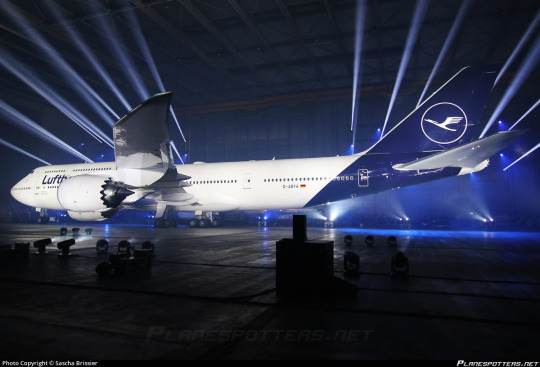
Even the presentation - good lord, is this an auto show?
My feelings on Lufthansa’s 2018 livery are visceral. There’s no mental evaluation required, no taking it in, thinking about the choices made - I look at the modern Lufthansa livery and immediately, profoundly know that I hate it. And that’s not just because of the specific choices made - which are bad - but because of the space they occupy amidst a creatively barren wasteland within livery design. This is going to be a very long post, which isn’t standard for this blog, but my goal for an introduction is to break down exactly the sort of design that made me feel the need to start doing this to begin with.

But in reality that’s only the beginning. Yes, Lufthansa’s livery is specifically disappointing, but it is so much more than that. It is the purest distillation of the greatest challenge aviation faces today, far weightier than scheduling issues, outdated IT, and runway incursions. It is not the worst example of it, not in the slightest, but it is a large airline which has a very textbook presentation of symptoms and thus feels like a great example to describe exactly what I hate about this sort of design. Let me explain.
Essentially, airlines have found a formula. It goes as such:
Almost entirely white body. (There is a name for this trend: Eurowhite.) In some cases, there may be a colour on the underside, generally either a light grey or whichever secondary shade the airline has committed to. In the case of this Lufthansa livery, it is just white.
Aside from the white body there will be either a single colour (generally some dark blue, or less often some sort of red) or a few colours, usually but not exclusively on flag carriers to match their national branding. (The proliferation of red, white, and blue flags out there means that a disproportionate number of airline liveries are these colours.) Unless it is literally just a white plane meant to be as generic as possible for short turn-overs when leasing, it will at least attempt to have some sort of design, but it will be minimal, and:
All of the detail will be on the tail. There may be coloured winglets or engine nacelles, but other than that it is only at the rear of the plane that you begin to see any interest. Usually this is just a logo, though it may be an abstract design which looks like a default tumblr header. It will often only be on the tail, with nothing at all on the body proper.
The name of the airline written in a sans-serif typeface which is set as default on at least one word processor. Rarely will anything creative be done with this. It will (usually, except in egregious cases) match the impotent attempt at graphic design which has been confined to the empennage and it will have all the charm of a large retail chain’s flyer describing the benefits you’ll definitely totally get if you work for them - sickeningly corporate. Low-cost airlines may slightly vary the theme by putting their website onto the livery, either towards the back or just instead of the airline’s name. The brave will also write it on the ventral fairing, but most don’t even bother with that simple act. Some airlines have their name written in the language spoken in the country they’re based in, usually beside the English text, but most are only in English despite operating in countries where this is not the most widely spoken language.
Not every livery which has these features is badly designed, as seemingly small changes can make all the difference. There is the occasional livery that fits most, if not all of these features that has some clever tweaks or design choices which makes me actually think it’s fine, acceptable, maybe even decent. (I have taken the initiative of making sure a few of these are among my early posts, just to demonstrate that it can be done). And some airlines depart from this entirely and come up with something even more hideous. Yet I somehow find myself respecting even these more than I do Lufthansa.
The Corporate Standard Livery Design (Lufthansesque design, if you will) is - and I do not think I am being dramatic at all here - an epidemic. Taxiing through most airports, you sometimes have to actually try to tell the planes parked around you apart in the sea of red, blue, and mostly white. And I spend a lot of time looking at planes.
These liveries do not only fail to inspire me. They instill in me a profound disgust. They are not trying to be good. They are trying to be what I described earlier - decent, not worth complaining about, because that’s cheaper and easier than designing something good. Graphic design is not anyone’s passion here. They’re just trying to toe the line. They’re so poisoned by the modern minimalist-design brain virus that they don’t realise that to be acceptable a livery this simple needs to do something interesting. There must be a creative decision made somewhere, a compelling feature, or you may as well be flying an MLA-formatted plane. In their striving for adequacy they become not just ambient, but lukewarm. They are a bottle of water which has sat in the sun for so long that when you drink it, even though you’re overheating and parched, it feels only negligibly better than the air you’ve been breathing in.
To be fair, I do not only hate the Lufthansa paintjob because it exemplifies whatever-ness. Even in an industry saturated with gross in-flight nothingburgers served with some stale biscuits and a paper cup of Lipton tea, Lufthansa manages to offend in specific and unique ways.
Throughout its long history Lufthansa has had a handful of different liveries, but from 2018 onwards this has been the situation. They’ve never been brilliant, but it’s only gotten worse over time. I normally would commit to a separate post for historical liveries, but in a move that I don’t foresee becoming particularly common I’d like to talk about the history and evolution of Lufthansa’s liveries from the golden age to now - the fall, if you will.

(image: lufthansa bildarchiv)
Their early liveries were already pretty much plain white or metal, but they still had a few features that made them seem a bit less like photocopy paper which was meant to be printed plain blue but only got through a tenth of the sheet before ink ran out. To begin with, they used a lighter blue and combined it with a vivid yellow to add some actual visual interest. The layering of the yellow over the blue where it curves around and below the nose and on the ends of the tailplane actually draws the eye. The font choice is nice and legible, spaced apart in the center of the fuselage. I imagine it was easy to read even from far away. (Shame it’s a bit blocked by the wings from some angles, though.)
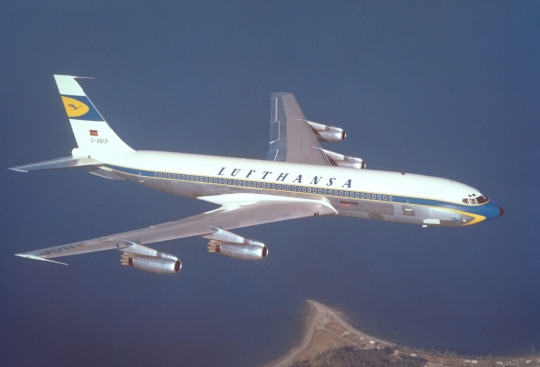
(image: lufthansa bildarchiv)
This early 707 design keeps the cheatlines extending past the nose but makes them sharper than the ones on the Connie to match the sleek profile of the jet. Back when this plane was painted adding white to your plane was a choice rather than the thing everybody was doing, which allows me to respect it for the choice it was instead of considering it the factory default. The bottom half, denoted by the cheatline, is left unpainted, which only adds to the sleekness of the overall profile, and the text is clear and plain but still aesthetically pleasing. The 707 is by modern standards pretty antique-looking; you can take one look at one and tell it isn’t particularly streamlined. This paint scheme, though, makes the plane look sharp and aerodynamic, despite not being revolutionary. I would go so far as to say I like this particular livery. This is, unfortunately, as good as it gets.

Oh. Oh no...
Let’s assess the damage here. The cheatlines now simply meet at the front without wrapping down to the belly of the plane and the nose is a simple black tip. I like it when airlines paint their planes’ radomes, and I wouldn’t mind it here if not for what it was replacing. The font has been replaced with a generic sans serif font which is closely spaced and put up into a corner, like the name on a homework assignment - it’s not really part of the total package, just there for administrative purposes. Most upsetting to me is the tail. While I wouldn’t say I love the little section on the old plane, it at least felt like it belonged there, creating a second blue-and-yellow layer above the white. Its placement on the fin above where it begins to taper gives the plane a bit of an aerodynamic feel. It’s certainly not changing the world, but it feels at home in the livery.
The new fin is a sharp downgrade. With nothing to mark the transition the fin abruptly goes from the white of the upper fuselage to a shiny blue which contains an enclave of the only yellow to be found on the entire aircraft. This makes the yellow stand out, as it has nothing to tie it in with the rest of the plane, and the fin itself feels almost like it’s been Frankensteined onto the fuselage from a different plane by a different airline. There’s nothing to mediate the transition from a block of white to a block of blue, like how the cheatline separates white and grey. It just is blue now, stop asking questions. This also means that the only part of the plane that the eye is really drawn to is...the tiny portion of the whole that is the fin, which may as well be floating detached in midair.
This is foreboding. Knowing what I know now, it feels like looking back at when a romantic partner began to act strange years later, after the divorce, as you walk by the house he bought with his mistress.
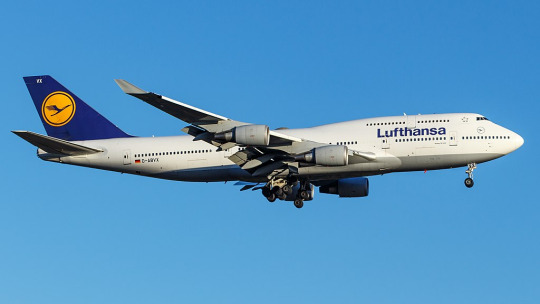
(image: g najberg)
The most recent, and only, time I flew on Lufthansa was in 2014 and was aboard one of their 747-400s. (Actually, if you’d still like to fly on a passenger 747, Lufthansa is basically your only option.) At the time, they looked like this. This is...just sad. They got rid of the cheatlines, because that’s trendy now, and they painted the whole plane white and made an attempt at lip service to the old metal lower half by painting just a bit of the plane grey, like if a human stepped into a puddle of paint that only covered the very sole of their foot. And I’m being generous by showing a 747, a plane which inherently makes any livery look less boring by being interestingly shaped itself, instead of the classic slightly pointy single-decker tube. Not to mention the double-decker design makes the text vertically centered instead of the default Lufthansa look of awkwardly shoved nearly all the way up the fuselage.
In defense of the modern livery, it’s possible to argue it’s an improvement on this. Honestly, looking at them next to each other, it’s difficult to pick out which one I find less defensible.

But then you see D-AIDV, an A321 painted in a heritage livery, and you feel the immediate, visceral “no!!! no go back!!!” as you remember that this is a false dichotomy and we could have something so much better if they weren’t peer-pressured into generic modern design.


And for what? For this?


(image: hvdfonts)
For the third time, I remind you of what we have been reduced to. We have achieved a state of reductio ad absurdum where this barely qualifies as a design. This plane is more or less a white blot. You can put as many insets as you want and it is still a white blot.
I am relatively sure that the font used is literally Helvetica. EDIT: I have been informed that it is not, in fact, Helvetica, but a custom typeface that happens to look almost exactly like Helvetica. This is, in my own opinion, worse! They did apparently use Helvetica in the past, though. Here is a very detailed description of the design process of the font, which manages to contain a grand total of zero ideas.
I would hate this on its own already, but it’s also so closely spaced and located so far up that it makes me feel like I’m suffocating. In my own experience as a dyslexic person, kerning is the single weightiest feature when it comes to if I can easily read something or not. While Helvetica, ugly though it may be, is generally considered a very legible font, any benefits from that are more than cancelled out by committing to making sure the entire name of the airline fits between the frontmost two doors with room to spare. It feels almost hostile.
Now, all given, I at least somewhat enjoy the shade of blue used for this livery, which is darker than the normal fare. I do miss the way the grey broke up the endless white space, though, and I mourn the yellow even more - in addition to being something to look at, losing it has also lost any visible reference to the flag of Germany, the country for which Lufthansa is the flag carrier. They don’t even have the black part of the German flag despite that being basically free. If they went for black instead of dark blue I would honestly respect this a hell of a lot more. One of the most recognizable flags in the world and instead your airline looks like a discount SAS.
Yeah, I said it. If we want to go even further with comparisons by including airlines that aren’t Lufthansa, this is basically the SAS livery. Except not, because the SAS livery does a lot that this doesn’t.
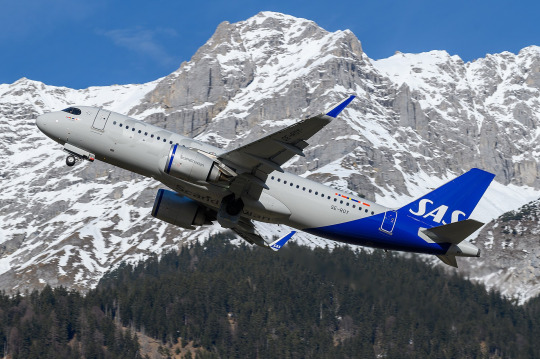
This is about Lufthansa, not SAS. I’ll look at SAS soon enough, because comparing their look to Lufthansa’s has made me appreciate it in a way I never used to. But I don’t think I need to elaborate too much for it to be clear why SAS’s livery works and Lufthansa’s doesn’t, despite the superficial similarities. SAS took their absolutely horrid previous livery and turned it into something which might not wow anyone but at least feels uniquely theirs, while Lufthansa had something which accomplished much the same and then diluted it into nothingness, Eurowhite writ large. Two washes and you’d wonder if your Lufthansa flight is actually a Smartlynx lease.
The way that the blue slices into the bottom of the fuselage and doesn’t fully cover the tailfin is...something? It’s a design element. It’s not nearly enough to save it, but it’s a design element. However, this presents another issue specific to Lufthansa’s paint job, best demonstrated with a specific plane:

(image: lufthansa)
Lufthansa is the world’s largest operator of the Airbus A340, a somewhat eccentric airplane which is perhaps best thought of as a four-engined A330. I love this airplane, and am delighted seeing it overhead on my walk home from work, because Lufthansa is kind enough to operate a daily service with it to my home airport, but that’s beside the point. The point is this: what I have pictured is specifically the A340-600, which is the world’s second longest in-service airliner. Yes, longer than the A380 and the 747-400, and, in fact, only shorter than the 747-800. With a plane this long, the Lufthansa livery creates an incredible look of rear-heaviness. This plane looks like it should uncontrollably pitch up until it’s perpendicular to the ground every time it takes off. Of course this effect is less pronounced on shorter aircraft, but it’s still there, and I dislike it.

You can barely even tell there’s paint at all on a much smaller plane! And the white bit on the front of the rudder which looks okay on a conventional empennage looks downright horrible when it’s only on the very tip of the t-tail’s forward point.

Oh, and when you take the windows out for a freighter conversion it gets even worse.
This is a generic-brand airplane. It genuinely reminds me of generic branding. There is a specific brand that has this exact appearance and I can’t remember what it is but it’s right there and I’m fairly sure I’ve seen it at CVS. I don’t think that’s what you want to go for when designing an airline livery, especially for an airline representing a country, but if Lufthansa wasn’t going for that they’ve failed.
__________________________________________
Overall, Lufthansa’s livery is superbly boring and not terribly well thought out. It’s not worth this absolute dissertation on its own, but I’ve singled it out to complain about general trends, and for that I probably owe it an apology. Said apology is predicated on the fact that it is still a very underwhelming and bad design which could have used a lot more thought. There are a million ways this could have been made decent, and none of them were implemented because that would have taken effort and time and creative vision. I think this post actually required more time and effort than Lufthansa put into designing their planes.
That said, Lufthansa gets a final grade of D. It’s...bad, it definitely is. There’s the vague flavour of the start of something, like the very distant smell from a barbecue happening three blocks away, but is that really even a redeeming factor?
No. The second-largest airline in Europe should be able to do better. If I have to stare at rows upon rows of their planes any time I’m at a German airport, they should have the decency to make them interesting to look at.
#tarmac fashion week#region: europe#region: west/central europe#lufthansa#region: germany#grade: d#era: 2010s#era: 2020s#era: 1950s#era: 1960s#era: 1970s#era: 1980s#era: 1990s#era: 2000s#retired liveries#flag carriers#double sunrise#long haul#lufthansa group#lufthansa line#scandinavian airlines system#deltalike
183 notes
·
View notes
Text
I'm not going to reblog the post, but I am once again going to fight people who use the Roman period as the evidence that all Jews, in modern times, are colonised people and Indigenous to Palestine
like, ok... Jews established kingdoms in Palestine as far back as the Bronze Age. the kingdom of Judah was then crushed by the Neo-Babylonian Exile, and many Jews were brought eastward in the Babylonian exile.
the conquest of Alexander the Great allowed a new kingdom, of Judea, to be established with its capital in Jerusalem. but not all Jews returned from the east, and Jews under Hellenistic rule also spread westward into Hellenized Egypt and northward into the Balkans. this was the situation when Rome conquered the Judean kingdom.
during the Roman period, Jews spread further into North Africa and Europe, establishing communities throughout the Roman Empire. when Judea was eventually crushed by the Romans and its citizens expelled, there was already an extant international Jewish community. the eastern community I mentioned from the Babylonian captivity had already existed for 500 years.
when Jews were expelled from Judea, many also eventually returned. a major community was almost immediately established in Tiberias, for instance. Jews would even resettle in Jerusalem. the Jerusalem Talmud was compiled a couple hundred years after the Roman expulsion.
so we start seeing these unique and widespread Jewish communities with their own minhagim (customs) and centuries to eventually millennia-long histories in Africa, Asia, and Europe. Jews were part of established pan-ethnic groups in these regions, so, for instance, there are Amazigh Jews, Arab Jews, Persian Jews, Russian Jews, French Jews, etc.
some of these communities in Africa and Asia would also go on to be colonised by European powers, such as France and the UK. colonisers like the French made distinctions between French Jews and native North African Jews.
Jews largely share common origins from the Near East, and there were Jewish kingdoms in Palestine whose histories are part of our religious identities, but we do not belong exclusively or even generally in Palestine more than wherever we found ourselves in the world. some of us are the colonised, but generally the displaced colonised of other parts of West or Central Asia or North Africa. others of us have been colonisers in those very same regions or elsewhere.
TL;DR Jews are diverse. we have a long history and geographically vast history that encompasses but is also much more than the Biblical narrative.
"Indigenous" in a political sense is not just being from somewhere, but having a relationship with a colonising power. and with that being said, Palestinians, the people being colonised by Israel, are Indigenous to Palestine.
558 notes
·
View notes
Text
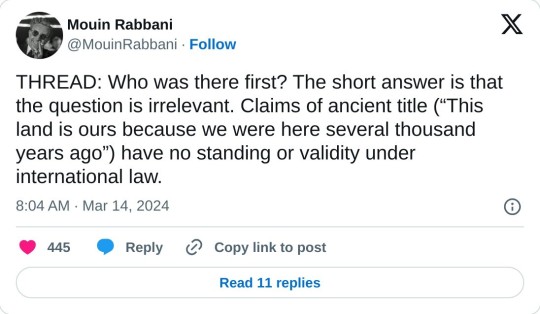
twitter thread by Mouin Rabbani
March 14, 2024
Who was there first? The short answer is that the question is irrelevant. Claims of ancient title (“This land is ours because we were here several thousand years ago”) have no standing or validity under international law.
For good reason, because such claims also defy elementary common sense. Neither I nor anyone reading this post can convincingly substantiate the geographical location of their direct ancestors ten or five or even two thousand years ago.
If we could, the successful completion of the exercise would confer exactly zero property, territorial, or sovereign rights.
As a thought experiment, let’s go back only a few centuries rather than multiple millennia. Do South Africa’s Afrikaners have the right to claim The Netherlands as their homeland, or even qualify for Dutch citizenship, on the basis of their lineage?
Do the descendants of African-Americans who were forcibly removed from West Africa have the right to board a flight in Atlanta, Port-au-Prince, or São Paolo and reclaim their ancestral villages from the current inhabitants, who in all probability arrived only after – perhaps long after – the previous inhabitants were abducted and sold into slavery half a world away?
Do Australians who can trace their roots to convicts who were involuntarily transported Down Under by the British government have a right to return to Britain or Ireland and repossess homes from the present inhabitants even if, with the help of court records, they can identify the exact address inhabited by their forebears? Of course not.
In sharp contrast to, for example, Native Americans or the Maori of New Zealand, none of the above can demonstrate a living connection with the lands to which they would lay claim.
To put it crudely, neither nostalgic attachment nor ancestry, in and of themselves, confer rights of any sort, particularly where such rights have not been asserted over the course of hundreds or thousands of years.
If they did, American English would be the predominant language in large parts of Europe, and Spain would once again be speaking Arabic.
Nevertheless, the claim of ancient title has been and remains central to Zionist assertions of not only Jewish rights in Palestine, but of an exclusive Jewish right to Palestine.
For the sake of argument, let’s examine it. If we put aside religious mythology, the origin of the ancient Israelites is indeed local.
In ancient times it was not unusual for those in conflict with authority or marginalized by it to take to the more secure environment of surrounding hills or mountains, conquer existing settlements or establish new ones, and in the ultimate sign of independence adopt distinct religious practices and generate their own rulers. That the Israelites originated as indigenous Canaanite tribes rather than as fully-fledged monotheistic immigrants or conquerors is more or less the scholarly consensus, buttressed by archeological and other evidence. And buttressed by the absence of evidence for the origin stories more familiar to us.
It is also the scholarly consensus that the Israelites established two kingdoms, Judah and Israel, the former landlocked and covering Jerusalem and regions to the south, the latter (also known as the Northern Kingdom or Samaria) encompassing points north, the Galilee, and parts of contemporary Jordan. Whether these entities were preceded by a United Kingdom that subsequently fractured remains the subject of fierce debate.
What is certain is that the ancient Israelites were never a significant regional power, let alone the superpower of the modern imagination.
There is a reason the great empires of the Middle East emerged in Egypt, Mesopotamia, Persia, and Anatolia – or from outside the region altogether – but never in Palestine.
It simply lacked the population and resource base for power projection. Jerusalem may be the holiest of cities on earth, but for almost the entirety of its existence, including the period in question, it existed as a village, provincial town or small city rather than metropolis.
Judah and Israel, like the neighboring Canaanite and Philistine entities during this period, were for most of their existence vassal states, their fealty and tribute fought over by rival empires – Egyptians, Assyrians, Babylonians, etc. – rather than extracted from others.
Indeed, Israel was destroyed during the eighth century BCE by the Assyrians, who for good measured subordinated Judah to their authority, until it was in the sixth century BCE eliminated by the Babylonians, who had earlier overtaken the Assyrians in a regional power struggle.
The Babylonian Exile was not a wholesale deportation, but rather affected primarily Judah’s elites and their kin. Nor was there a collective return to the homeland when the opportunity arose several decades later after Cyrus the Great defeated Babylon and re-established a smaller Judah as a province of the Persian Achaemenid empire. Indeed, Mesopotamia would remain a key center of Jewish religion and culture for centuries afterwards.
Zionist claims of ancient title conveniently erase the reality that the ancient Israelites were hardly the only inhabitants of ancient Palestine, but rather shared it with Canaanites, Philistines, and others.
The second part of the claim, that the Jewish population was forcibly expelled by the Romans and has for 2,000 years been consumed with the desire to return, is equally problematic.
By the time the Romans conquered Jerusalem during the first century BCE, established Jewish communities were already to be found throughout the Mediterranean world and Middle East – to the extent that a number of scholars have concluded that a majority of Jews already lived in the diaspora by the time the first Roman soldier set foot in Jerusalem.
These communities held a deep attachment to Jerusalem, its Temple, and the lands recounted in the Bible. They identified as diasporic communities, and in many cases may additionally have been able to trace their origins to this or that town or village in the extinguished kingdoms of Israel and Judah. But there is no indication those born and bred in the diaspora across multiple generations considered themselves to be living in temporary exile or considered the territory of the former Israelite kingdoms rather than their lands of birth and residence their natural homeland, any more than Irish-Americans today feel they properly belong in Ireland rather than the United States.
Unlike those taken in captivity to Babylon centuries earlier, there was no impediment to their relocation to or from their ancestral lands, although economic factors appear to have played an important role in the growth of the diaspora.
By contrast, those traveling in the opposite direction appear to have done so, more often than not, for religious reasons, or to be buried in Jerusalem’s sacred soil.
Nations and nationalism did not exist 2,000 years ago.
Nor Zionist propagandists in New York, Paris, and London incessantly proclaiming that for two millennia Jews everywhere have wanted nothing more than to return their homeland, and invariably driving home rather than taking the next flight to Tel Aviv.
Nor insufferably loud Americans declaring, without a hint of irony or self-awareness, the right of the Jewish people to Palestine “because they were there first”.
Back to the Romans, about a century after their arrival a series of Jewish rebellions over the course of several decades, coupled with internecine warfare between various Jewish factions, produced devastating results.
A large proportion of the Jewish population was killed in battle, massacred, sold into slavery, or exiled. Many towns and villages were ransacked, the Temple in Jerusalem destroyed, and Jews barred from entering the city for all but one day a year.
Although a significant Jewish presence remained, primarily in the Galilee, the killings, associated deaths from disease and destitution, and expulsions during the Roman-Jewish wars exacted a calamitous toll.
With the destruction of the Temple Jerusalem became an increasingly spiritual rather than physical center of Jewish life. Jews neither formed a demographic majority in Palestine, nor were the majority of Jews to be found there.
Many of those who remained would in subsequent centuries convert to Christianity or Islam, succumb to massacres during the Crusades, or join the diaspora. On the eve of Zionist colonization locally-born Jews constituted less than five per cent of the total population.
As for the burning desire to return to Zion, there is precious little evidence to substantiate it. There is, for example, no evidence that upon their expulsion from Spain during the late fifteenth century, the Sephardic Jewish community, many of whom were given refuge by the Ottoman Empire that ruled Palestine, made concerted efforts to head for Jerusalem. Rather, most opted for Istanbul and Greece.
Similarly, during the massive migration of Jews fleeing persecution and poverty in Eastern Europe during the nineteenth century, the destinations of choice were the United States and United Kingdom.
Even after the Zionist movement began a concerted campaign to encourage Jewish emigration to Palestine, less than five per cent took up the offer. And while the British are to this day condemned for limiting Jewish immigration to Palestine during the late 1930s, the more pertinent reality is that the vast majority of those fleeing the Nazi menace once again preferred to relocate to the US and UK, but were deprived of these havens because Washington and London firmly slammed their doors shut.
Tellingly, the Jewish Agency for Israel in 2023 reported that of the world’s 15.7 million Jews, 7.2 million – less than half – reside in Israel and the occupied Palestinian territories.
According to the Agency, “The Jewish population numbers refer to persons who define themselves as Jews by religion or otherwise and who do not practice another religion”.
It further notes that if instead of religion one were to apply Israel’s Law of Return, under which any individual with one or more Jewish grandparent is entitled to Israeli citizenship, only 7.2 of 25.5 million eligible individuals (28 per cent) have opted for Zion.
In other words, “Next Year in Jerusalem” was, and largely remains, an aspirational religious incantation rather than political program. For religious Jews, furthermore, it was to result from divine rather than human intervention.
For this reason, many equated Zionism with blasphemy, and until quite recently most Orthodox Jews were either non-Zionist or rejected the ideology altogether.
Returning to the irrelevant issue of ancestry, if there is one population group that can lay a viable claim of direct descent from the ancient Israelites it would be the Samaritans, who have inhabited the area around Mount Gerizim, near the West Bank city of Nablus, without interruption since ancient times.
Palestinian Jews would be next in line, although unlike the Samaritans they interacted more regularly with both other Jewish communities and their gentile neighbors.
Claims of Israelite descent made on behalf of Jewish diaspora communities are much more difficult to sustain. Conversions to and from Judaism, intermarriage with gentiles, absorption in multiple foreign societies, and related phenomena over the course of several thousand years make it a virtual certainty that the vast majority of Jews who arrived in Palestine during the late 19th and first half of the 20th century to reclaim their ancient homeland were in fact the first of their lineage to ever set foot in it.
By way of an admittedly imperfect analogy, most Levantines, Egyptians, Sudanese, and North Africans identify as Arabs, yet the percentage of those who can trace their roots to the tribes of the Arabian Peninsula that conquered their lands during the seventh and eighth centuries is at best rather small.
Ironically, a contemporary Palestinian, particularly in the West Bank and Galilee, is likely to have more Israelite ancestry than a contemporary diaspora Jew.
The Palestinians take their name from the Philistines, one of the so-called Sea Peoples who arrived on the southern coast of Canaan from the Aegean islands, probably Crete, during the late second millennium BCE.
They formed a number of city states, including Gaza, Ashdod, and Ashkelon. Like Judah and Israel they existed primarily as vassals of regional powers, and like them were eventually destroyed by more powerful states as well.
With no record of their extermination or expulsion, the Philistines are presumed to have been absorbed by the Canaanites and thereafter disappear from the historical record.
Sitting at the crossroads between Asia, Africa, and Europe, Palestine was over the centuries repeatedly conquered by empires near and far, absorbing a constant flow of human and cultural influences throughout.
Given its religious significance, pilgrims from around the globe also contributed to making the Palestinian people what they are today.
A common myth is that the Palestinian origin story dates from the Arab-Muslim conquests of the seventh century. In point of fact, the Arabs neither exterminated nor expelled the existing population, and the new rulers never formed a majority of the population.
Rather, and over the course of several centuries, the local population was gradually Arabized, and to a large extent Islamized as well.
So the question as to who was there first can be answered in several ways: “both” and “irrelevant” are equally correct.
Indisputably, the Zionist movement had no right to establish a sovereign state in Palestine on the basis of claims of ancient title, which was and remains its primary justification for doing so.
That it established an exclusivist state that not only rejected any rights for the existing Palestinian population but was from the very outset determined to displace and replace this population was and remains a historical travesty.
That it as a matter of legislation confers automatic citizenship on millions who have no existing connection with the land but denies it to those who were born there and expelled from it, solely on the basis of their identity, would appear to be the very definition of apartheid.
The above notwithstanding, and while the Zionist claim of exclusive Israeli sovereignty in Palestine remains illegitimate, there are today several million Israelis who cannot be simply wished away.
A path to co-existence will need to be found, even as the genocidal nature of the Israeli state, and increasingly of Israeli society as well, makes the endeavor increasingly complicated.
The question, thrown into sharp relief by Israel’s genocidal onslaught on the Palestinian population of the Gaza Strip, is whether co-existence with Israeli society can be achieved without first dismantling the Israeli state and its ruling institutions.
253 notes
·
View notes
Note
Man, the Russia/Ukraine war has led to a lot of terrible takes from far leftists. I have a mutual from Brazil, a self identified socialist, who is convinced that Ukraine is full of nazis. While they don't support Russia, they questioned why they have to be "pro-Ukraine" or "pro-Russia". They call Ukraine a "nazi hole" but call Russia merely "fascist". Am I wrong in thinking that they've been influenced by Russian propaganda? I know Ukraine does have a nazi/far right problem, but so does the US? And most European countries? idk they strongly hate the US/US government too, and it seems to create some kind of brainrot. at least they don't blindly support China or Russia like tankies do (nor identify with them), but it's still frustrating to take a neutral position on a pretty black and white situation.
I don't want to confront them 1) cause I'm not the type to argue over serious things like this and this may break our long friendship and 2) I'm not super educated on the nazi situation in Ukraine.
Anyway thank you for letting me rant in your inbox.
Yes, Russia has specifically focused its propaganda efforts on Latin America, Africa, and other regions that HAVE suffered from Western/European/American imperialism and are thus predisposed to take the worst view of them/believe that this situation is their fault somehow. This is similar to what the USSR did in newly postcolonial Africa in the 1960s and 1970s, positing themselves as offering the shared hand of communist brotherhood from Western oppressors. Because of more recent events like the invasion of Iraq, which was fully as unjustified as the invasion of Ukraine, Russian propagandists and their eager tankie/leftist foot soldiers have also got a lot of mileage out of "whataboutism." This is likewise an old Soviet propaganda technique designed to deflect any criticism of the actual situation by disingenuously asking "what about this other one!!!"
Likewise, the idea that Ukraine has a "Nazi problem" is itself propaganda. In the last election, far-right/Nazi-identified parties won barely 2% of the vote and AFAIK, no seats at all in the Verkhovna Rada (Ukrainian parliament). This is far lower than the nearly half of the USA voting for the far-right/Nazi-sympathetic Republican Party, and as noted, the far right elements in the UK and Europe. The idea that Ukraine is "full of Nazis" (with a Jewish president who just celebrated iftar with the Ukrainian Muslims/Crimean Tatars during Ramadan and instituted observance of Muslim holidays nationwide, very Nazi of him) is a line used by Russian propagandists to "justify" their attack and appeal to national memories of the Great Patriotic War (World War II) and the struggle against the Nazis, which is the central cultural grievance/memory in modern Russia. The Putin regime has referred to anyone they don't like, but especially the Ukrainians, as "Nazis" for a long time now, so it's supposedly their holy duty to kill them/commit ethnic cleansing/forcibly reunite the "fraternal" people of "Little Russia," as Ukraine has been called since the 17th century, with "Great Russia." And yeah, no.
Because the West and Europe has been pretty solidly on Ukraine's side, Russia has therefore cultivated countries like China, India, Brazil, etc, who have all suffered from Western interference and are looking to move into the first rank of global superpowers. This is, as noted, similar to the competing systems of influence built during the Cold War, but it also relies on much deeper Russian grievances that go back to the medieval era. Anybody who knows a thing about actual Russian history would therefore know that every single word it says about the Ukraine situation is a lie, but because that lie is useful for many other countries and fits into their own understanding of themselves, it is easy to repeat and act like it's a so-called superior moral position. This is also why US/American tankies so eagerly lap up Russian propaganda, because it plays into their moral sense of themselves as far better than the rest of the West and "righteously" discovering that the West is responsible for all the evil in the world etc etc. While non-Westerners are just helpless misunderstood puppets with no real agency or ability to make complex choices. This totally makes sense!!!
#anonymous#ask#russia ukraine war#russian history#as ever tankies are the fucking absolute worst and wrong about everything
666 notes
·
View notes
Note
The projected number of Palestinians living in State of Palestine at the end of 2015 is 4.75 million: around 2.90 million reside in the West Bank and 1.85 million in Gaza Strip
The population growth rate stands high at 2.8% and it is expected to remain stable due to decline in mortality rates while fertility rate remains one of the highest in the Arab region standing at 4.06, with high disparity between Gaza and West Bank, 4.5 and 3.6 respectively.
The average age of population is increasing; the proportion of children below 15 declined to 39%, while the working age population is increasing reaching 57% in 2014.
https://palestine.unfpa.org/en/population-matters-0
https://www.pcbs.gov.ps/portals/_pcbs/PressRelease/Press_En_InterPopDay2022E.pdf
The second link is the government of palestine. It shows no mass population decline, the sort of small drop in average family size as people become more well off and stable, and a decrease in illiteracy and childhood problems.
Literally the opposite of a genocide. There is no jewish run genocide you're just a jew hater, mad at your parents or society in general, projecting and spewing terrorist propaganda
White supremacist obsession with non white birthrates being used as pretext for genocide denial. "Look how many kids theyre having! We can't be killing and displacing them." Nazi rhetoric. Southern white slaver rhetoric. Half of Gaza's population is children, everyone knows this, fears about Palestinain birthrate outstripping Israei birthrates is one of the central neuroses fueling modern Zionism and you repeat it like it's exhonerating. You type this out while Israeli military and government officials explicitly state their intention to depopulate Gaza, while racist right wing extremist settler militias commit pogroms across the west Bank with the backing of the IDF and with the tacit approval of Europe and the United States.
286 notes
·
View notes
Photo

Countries where German is the official language.
by languages.eu
German is a West Germanic language mainly spoken in Western Europe and Central Europe.
It is the most widely spoken and official or co-official language in Germany, Austria, Switzerland, Liechtenstein, and the Italian province of South Tyrol. It is also an official language of Luxembourg and Belgium, as well as a recognized national language in Namibia.
Outside Germany, it is also spoken by German communities in France (Alsace), Czech Republic (North Bohemia), Poland (Upper Silesia), Slovakia (Košice Region, Spiš, and Hauerland), and Hungary (Sopron).
157 notes
·
View notes
Note
Where do you reside in?
Options:
North America
Central/ South America/ Caribbean
Western Europe
Eastern Europe
North Africa
Sub-Saharan Africa
Northern Asia
Central/ Western/ Southern Asia
Eastern/ Southeastern Asia
Oceania
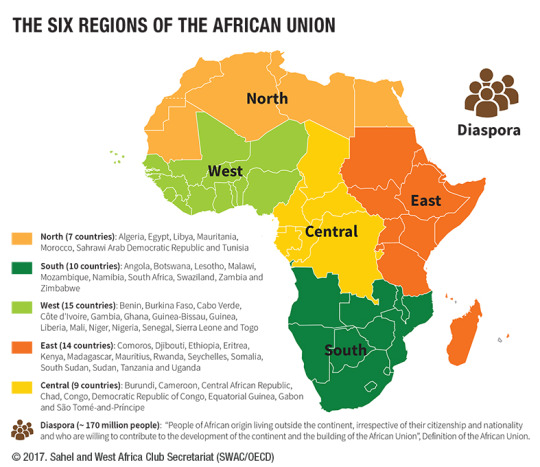
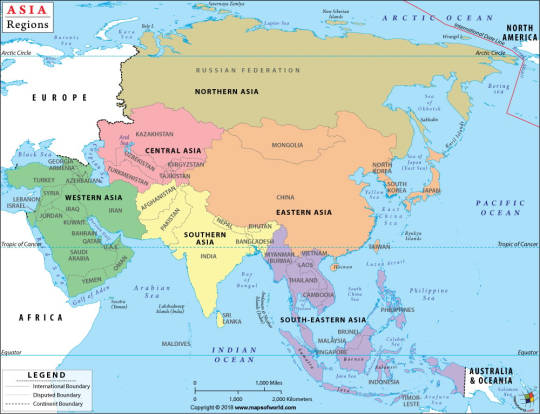
Here is the second part of this poll, with more specific regions of Europe.
And here's a master poll with US states.
Use 🫘/☕️/🌶 and so on, if you'd like to share your answer in the tags.
Tag / comment your country and reblog for a bigger sample size! 🇦🇹 🇧🇼 🇨🇺 🇧🇷 🇫🇰 🇮🇳 🇮🇸
#tumbler polls#tumblr polls#Europe#Asia#Africa#Oceania#America#demographic polls#countries#geography
184 notes
·
View notes
Text
"Growing flax to make linen was one of the oldest human activities in Europe, particularly in the Rhineland. Archeologists have found linen textiles among the settlements of Neolithic cultivators along the shores of Lake Neuchâtel in the Jura Mountains west of Bern, Switzerland. These were elaborate pieces: Stone Age clothmakers of the Swiss lakeshores sewed pierced fruit pits in a careful line into a fabric with woven stripes. The culture spread down the Rhine and into the lowland regions.
The Roman author Pliny observed in the first century AD that German women wove and wore linen sheets. By the ninth century flax had spread through Germany. By the sixteenth century, flax was produced in many parts of Europe, but the corridor from western Switzerland to the mouth of the Rhine contained the oldest region of large-scale commercial flax and linen production. In the late Middle Ages the linen of Germany was sold nearly everywhere in Europe, and Germany produced more linen than any other region in the world.
At this juncture, linen weavers became victims of an odd prejudice. “Better skinner than linen weaver,” ran one cryptic medieval German taunt. Another macabre popular saying had it that linen weavers were worse than those who “carried the ladders to the gallows.” The reason why linen weavers were slandered in this way, historians suspect, was that although linen weavers had professionalized and organized themselves into guilds, they had been unable to prevent homemade linen from getting onto the market. Guilds appeared across Europe between the twelfth and fifteenth centuries but many of the items they produced for exchange, like textiles and soap, were also produced at home right up through the nineteenth century. The intricate regulations of the guilds—determining who could join, how they would be trained, what goods they would produce, and how these could be exchanged—were mainly designed to distinguish guild work from this homely labor. That linen making continued to be carried out inside of households—a liability for guilds in general—lent a taint to the linen guild in particular.
In the seventeenth century, guilds came under pressure from a new, protocapitalist mode of production. Looking for cheaper cloth to sell on foreign markets, entrepreneurs cased the Central European countryside offering to pay cash to home producers for goods. Rural households became export manufacturing centers and a major source of competition with the guilds. These producers could undercut the prices of urban craftsmen because they could use the unregulated labor of their family members, and because their own agricultural production allowed them to sell their goods for less than their subsistence costs.
The uneasiness between guild and household production in the countryside erupted into open hostility. In the 1620s, linen guildsmen marched on villages, attacking competitors, and burning their looms. In February 1627 Zittau guild masters smashed looms and seized the yarn of home weavers in the villages of Oderwitz, Olbersdorf, and Herwigsdorf.
Guilds had long worked to keep homemade products from getting on the market. In their death throes, they hit upon a new and potent weapon: gender. Although women in medieval Europe wove at home for domestic consumption, many had also been guild artisans. Women were freely admitted as masters into
the earliest medieval guilds, and statutes from Silesia and the Oberlausitz show that women were master weavers. Thirteenth-century Paris had eighty mixed craft guilds of men and women and fifteen female-dominated guilds for such trades as gold thread, yarn, silk, and dress manufacturing. Up until the mid-seventeenth century, guilds had belittled home production because it was unregulated, nonprofessional, and competitive. In the mid-seventeenth century this work was identified as women’s work, and guildsmen unable to compete against cheaper household production tried to eject women from the market entirely. Single women were barred from independent participation in the guilds. Women were restricted to working as domestic servants, farmhands, spinners, knitters, embroiderers, hawkers, wet nurses. They lost ground even where the jobs had been traditionally their own, such as ale brewing and midwifery, by the end of the seventeenth century.
The wholesale ejection of women from the market during this period was achieved not only through guild statute, but through legal, literary, and cultural means. Throughout the sixteenth and seventeenth centuries women lost the legal right to conduct economic activity as femes soles. In France they were declared legal “imbeciles,” and lost the right to make contracts or represent themselves in court. In Italy, they began to appear in court less frequently to denounce abuses against them. In Germany, when middle-class women were widowed it became customary to appoint a tutor to manage their affairs. As the medieval historian Martha Howell writes, “Comedies and satires of this period…often portrayed market women and trades women as shrews, with characterizations that not only ridiculed or scolded them for taking on roles in market production but frequently even charged them with sexual aggression.” This was a period rich in literature about the correction of errant women: Shakespeare’s The Taming of the Shrew (1590–94), John Ford’s ’Tis Pity She’s a Whore (1629–33), Joseph Swetnam’s “The Araignment of Lewde, Idle, Froward, and Unconstant Women” (1615). Meanwhile, Protestant reformers and Counter-Reformation Catholics established doctrinally that women were inherently inferior to men.
This period, called the European Age of Reason, successfully banished women from the market and transformed them into the sweet and passive beings that emerged in Victorian literature. Women accused of being scolds were paraded in the streets wearing a new device called a “branks,” an iron muzzle that depressed the tongue. Prostitutes were subjected to fake drowning, whipped, and caged. Women convicted of adultery were sentenced to capital punishment.
As a cultural project, this was not merely recreational sadism. Rather, it was an ideological achievement that would have lasting and massive economic consequences. Political philosopher Silvia Federici has argued this expulsion was an intervention so massive, it ought to be included as one of a triptych of violent seizures, along with the Enclosure Acts and imperialism, that allowed capitalism to launch itself.
Part of why women resisted enclosure so fiercely was because they had the most to lose. The end of subsistence meant that households needed to rely on money rather than the production of agricultural goods like cloth, and women had successfully been excluded from ways to earn. As labor historian Alice Kessler-Harris has argued, “In pre-industrial societies, nearly everybody worked, and almost nobody worked for wages.” During the sixteenth and seventeenth centuries, monetary relations began to dominate economic life in Europe. Barred from most wage work just as the wage became essential, women were shunted into a position of chronic poverty and financial dependence. This was the dominant socioeconomic reality when the first modern factory, a cotton-spinning mill, opened in 1771 in Derbyshire, England, an event destined to upend still further the pattern of daily life."
- Sofi Thanhauser, Worn: A People's History of Clothing
#radical feminism#feminism#linen#history of clothing#sexism#female oppression#the rights they TOOK from us#i'm so pissed#i knew there would be misogyny in history of clothing#but this made my blood burn#Sofi Thanhauser
96 notes
·
View notes
Text
Thinking about the Holocaust in Africa.
Here, European notions of anti-Blackness and antisemitism became intertwined.
There was a fusion between the dispossession and racism of European imperialism and colonization projects of the late nineteenth century, and the prison regimes imposed by European fascism in the early twentieth century.
Scholars Sarah Abrevaya Stein and Aomar Boum have recently written much about the importance of recognizing the trauma of labor and internment camps in North Africa during the second world war.
And I want to express my gratitude for their work. I want to share some of what they’ve written in a couple of recent articles.
In their words: “Nazism in Europe was underlaid by an intricate matrix of racist, eugenicist and nationalist ideas. But the war – and the Holocaust – appears even more complex if historians take into account the racist and violent color wheel that spun in North Africa.” [1]
France's prison camps in North Africa were filled with Algerians, local Jews, deported European Jews, Eastern European refugees, domestic political dissidents from France, people fleeing fascist Spain, Moroccan residents, Senegalese subjects of French rule, other West Africans displaced by French occupation, and more.
The anti-Blackness and antisemitism that had fueled Europe's colonial expansion was finding new expression in fascist Europe.
---
Seems France is a central antagonist in the story of evolving approaches to empire, racism, and resource extraction.
After their 1940 alliance with the Nazis, the Vichy French government maintained technical control of French colonies across Africa. Beginning in 1940, the French government “alone built nearly 70 such camps in the Sahara.” [1] This was in addition to another six labor camps which the French government built in West Africa (in Senegal, Guinea, and Mali).
---
By the beginning of the twentieth century, French-influenced or -controlled territory in North Africa was home to around 500,000 Jews, many of whom had been living in the region for centuries or millennia, speaking many languages, “reflecting their many different cultures and ethnicities: Arabic, French, Tamazight – a Berber language – and Haketia, a form of Judeo-Spanish spoken in northern Morocco.” [1] The Vichy French government officially stripped North African Jews of formal citizenship and seized their assets.
Then, deporting residents of Europe and political dissidents in “early 1941, the Vichy authorities transferred hundreds of Jewish and non-Jewish refugees, including women and children, to the Saharan labor camps.” [2] Under French rule “in Algeria [...], it was estimated that 2,000-3,000 Jews were interned in camps [...] resulting in a total prisoner population of 15,000-20,000.” [2] France pursued an “unrealized dream of the nineteenth century” [2]: the completion of the Mediterranean-Niger railroad line in the Sahara, a transportation route across the vast desert to connect the prosperous West African port of Dakar with the Mediterranean coast of Algeria.
Meanwhile the “Vichy regime [...] continued racist policies begun by France’s Third Republic, which pushed young Black men from the empire into forced military service,” including forced recruitment from “Senegal, French Guinea, Ivory Coast, Niger and Mauritania; [...] Benin, Gambia and Burkina Faso; and Muslim men from Morocco and Algeria. In these ways, the French carried on a wartime campaign of anti-Blackness and Islamophobia, pairing these forms of racialized hatred from the colonial era with antisemitism. Antisemitism had deep roots in French and colonial history, but it found new force in the era of fascism.” [1]
---
In late 1942, during the Nazi occupation of Tunisia, the SS “imprisoned some 5,000 Jewish men in roughly 40 forced labor and detention camps on the front lines and in cities like Tunis.” [2] The fascist Italian government had been experimenting with racist and anti-Black policy in their colonization of East Africa; these policies were expanded in Libya. Here, “Mussolini ordered the Jews of Cyrenaica moved” as “most of the 2,600 Jews deported [...] were sent to the camp of Giado” while “other Libyan Jews were deported to the camps of Buqbuq and Sidi Azaz.” [2]
---
Stein and Boum describe the diversity of prisoner experience: “In these camps, [...] the complex racist logic of Nazism and fascism took vivid form. Muslims arrested for anti-colonial activities were pressed into back-breaking labor” and “broke bread with other forced workers” including ‘Ukrainians, Americans, Germans, Russian Jews and others [...] arrested, deported and imprisoned by the Vichy regime after fleeing Franco’s Spain. There were political enemies of the Vichy and Nazi regime too, including socialists, communists, union members [...] overseen by [...] forcibly recruited [...] Moroccan and Black Senegalese men, who were often little more than prisoners themselves.” [1]
As Stein and Boum describe it: “Vichy North Africa became a unique site [...] where colonialism and fascism co-existed and overlapped.” [2]
They write: “Together, we have spent a decade gathering the voices of the diverse peoples who endured World War II in North Africa, across lines of race, class, language and region. Their letters, diaries, memoirs, poetry and oral histories are both defiant and broken. They express both faith and despair. All in all, they understood themselves to be trapped in a monstrous machine of fascism, occupation, violence and racism.” [1]
---
[1]: Sarah Abrevaya Stein and Aomar Boum. “80 years ago, Nazi Germany occupied Tunisia - but North Africans’ experiences of World War II often go unheard.” The Conversation. 15 November 2022.
[2]: Sarah Arbevaya Stein and Aomar Boum. “Labor and Internment Camps in North Africa.” Holocaust Encyclopedia online. Last edited 13 May 2019.
560 notes
·
View notes
Text
No. 55 - British Airways, Part One - British (European) Airways and British (Overseas) Airways (Corporation)
British Airways.
Starting this post was harder than actually writing it. It's hard to start a post about British Airways, because it's a deceptively weird airline. If you very precisely altered my memory, kept my knowledge of the United Kingdom and of flag carriers but erased all I knew about British Airways and asked me to speculate about the UK's flag carrier, what I came up with would look absolutely nothing like British Airways. British Airways is weird. It was weird when it came into existence in 1974. It's weird now. It's a completely typical airline in terms of things like...routes and safety and in-flight meals and...I don't know...contribution to human rights abuses. But that's not what I talk about here.

The story of British Airways' livery is interesting. It's messy. It's political. All of that comes in due time. More than most other airlines, it just can't keep to a livery for too long - and that's when it even has a livery. In its early youth, British Airways couldn't really figure itself out at all. And in its even earlier youth...well, actually, British Airways isn't that old. It's also not the UK's first flag carrier.
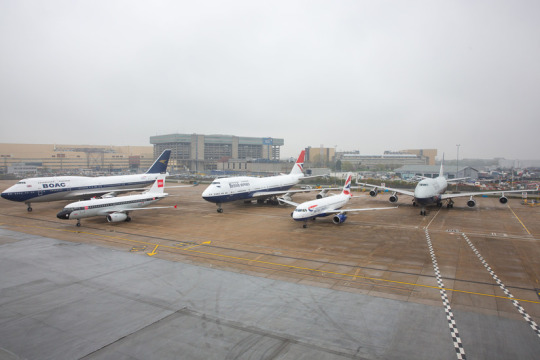
image: British Airways
There is a reason that two of British Airways' fleet of retro liveries wear wordmarks that say other names. To discuss the history of the British Airways livery, I have to first begin by discussing the fact that British Airways...is a weird airline.

British Airways. IATA code BA, ICAO code BAW, callsign SPEEDBIRD. Flag carrier of the United Kingdom.

Honestly a better logo than at least 40% of actual airlines.
Well, it's actually a subsidiary of the unimaginatively named International Airlines Group, Europe's third-largest airline holding company, below Ryanair and the Lufthansa Group but ahead of Air France-KLM. IAG is a member of the oneworld alliance and is the parent company of British Airways, Iberia, Aer Lingus, Vueling, and LEVEL, and just last year acquired Air Europa and began the process of absorbing it away from SkyTeam. To anyone who may have had the thought enter their head: yes, they do now basically have a monopoly on Spanish airlines. To any Spaniards reading, my condolences. At least you still have EasyJet.
Their largest shareholder is Qatar Airways, so when you really think about it British Airways is kind of a subsidiary of Qatar Airways a little bit. Their share is still only 25%, though, so that actually just completely isn't true, but in a vibes sense it feels that way from the outside looking in. Of course, all these airlines have maintained their own identities and operate independently. This is not a LATAM situation. British Airways adopted its present-day livery long before it merged with Iberia to form the IAG in 2011. I'm still not totally sure why they did that. Maybe they wanted to one-up Air France. Iberia's not exactly KLM, but - no, this is not that post.

British Airways. I've always thought it was a little bit strange that it was called that. Few places love reminding the world they're at least nominally still a monarchy more than England. KLM isn't the only airline with 'Royal' in the name - Royal Air Maroc, Royal Jordanian Airlines, and Royal Brunei Airlines are just a few other examples. And yet the United Kingdom has never had an airline, at least not a major one, named anything like The Queen's Royal Air Fleet, which is what I would have expected of them. No. British Airways.
There's not much gravitas to that, is there? Not really any punch. Nothing making it better than Air France. 'British Airways' is a pretty sterile name for a flag carrier.
Their callsign is SPEEDBIRD, though. And that's not sterile. That's awesome. That's Europe's equivalent to Pan Am's CLIPPER or China Airlines' DYNASTY, just pure style. But what is a speedbird, other than a really cool name for a jet?

This is a speedbird. Rather, this is the logo for Imperial Airways. Not to be confused with the very strangely named 1964-1986 Californian commuter airline Imperial Airlines, Imperial Airways was a very early precursor to what British Airways is now. In the inter-war years it served destinations like South Africa, Hong Kong, and Australia - the sorts of places two dozen or so wealthy individuals of power might have reason to go quickly. Unlike Imperial Airlines, Imperial Airways had a very fitting name.
So here's another weird thing about British Airways: it's young. Really young for what it is. Most flag carriers are pretty old, and the few exceptions are airlines founded in the 21st century to replace flag carriers which went defunct in the 90s and on, like Brussels Airlines or ITA Airways. Even when you discount centenarians like KLM and Finnair, most of the names you'd recognize in the rest of the world (and plenty you probably haven't heard of) existed by the 1940s, with the major Axis powers being forced to reboot theirs in the 50s. Even the places Imperial Airways served, despite not having the resources of an empire at their disposal, have far older flag carriers. British Airways didn't exist until 1974, making it younger than my mother, the Boeing 747, the Twin Towers, 2001: A Space Odyssey, and the moon landing.
The primary reason for this was, as far as I can tell, bureaucratic shuffling about, but I'm not especially well-versed or interested in the history of UK corporations so that's where I'll leave this bit off. It is possible, and indeed likely, that someone reading this has the urge to say that I'm being uncharitable and that British Airways is functionally just BOAC or BOAC is just functionally Imperial Airways (or maybe nobody thinks that - I simply don't know enough about the corporate side of it to confidently dismiss the possibility of this indeed being the case). It's just not relevant because I'm ultimately here to talk about the airline as an entity in the public eye that has a livery, and in this sense Imperial Airways, British Airways, and the intermediate steps are fully distinct. So, for my taste, British Airways began operations less than a month before the release of the novel "Carrie". That's strange. British Airways is strange.
Still, even though in most other cases the process was significantly faster, very few flag carriers we'd recognize today were founded outright in their current state.
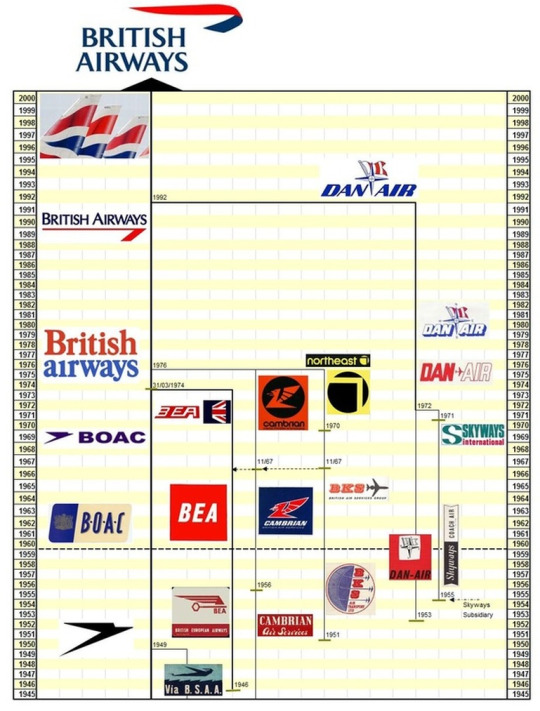
This timeline, compiled by Yesterday's Airlines, documents the 'family tree' of airline mergers that has built up today's British Airways. It actually goes back far earlier. Debatably it began with manufacturer Airco and its subsidiary airline Aircraft Transport and Travel, founded in 1916. Though it went under in 1920, its assets were repurposed by Daimler Airway (singular), which was one of the four airlines (mostly all subsidiaries of aircraft manufacturers) which in 1924 became Imperial Airways. That's right, even the building blocks on this chart are themselves built from blocks!
There are plenty more long-forgotten airline mergers beneath where this graphic cuts off, but this is all to say that the speedbird emblem originated with Imperial Airways, and it has floated to the top of this soup of assorted vaguely British brands, many of which nobody has thought about in decades. Speedbird aside, British Airways resembles basically none of its component parts in any ways that aren't just explained by them both being British, and Airways.
The speedbird was created by notable art deco designer Theyre Lee-Elliott, who created several pieces of iconography and many graphics and posters for the UK government, among other things, like the first-edition cover of "A Farewell to Arms" that an English teacher of mine once had as a poster on her wall. Much of his early work was for airlines, and the speedbird happened to stick.
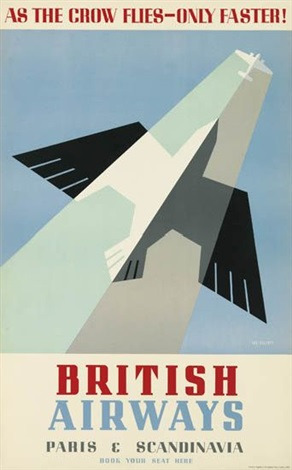
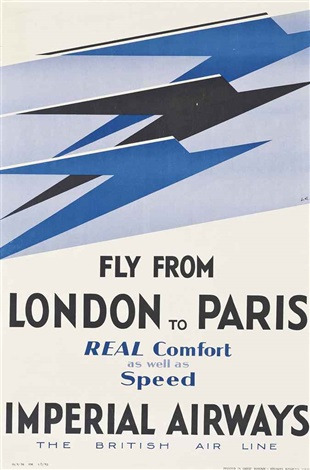
Left poster isn't anachronistic - 'British Airways' was the name of a late-30s airline, itself merged from three other airlines, which would go on to join Imperial Airways as one of the components of BOAC.
Airlines didn't really have liveries as we know them now back when the speedbird was invented, so it would lie dormant as an emblem used on posters and signage for a little while. It was the only part of Imperial Airways' identity which survived when, in 1939, it merged into the British Overseas Airways Corporation.

'British Overseas Airways Corporation' has the same nostalgic punch to it as 'Pan American World Airways'. It was almost always just called BOAC, though, even in the wordmarks of its airplanes. When BOAC came into being the airplane livery was not what it is today. They began with just a painted tail and cheatline, scarcely worth showing or commenting on.
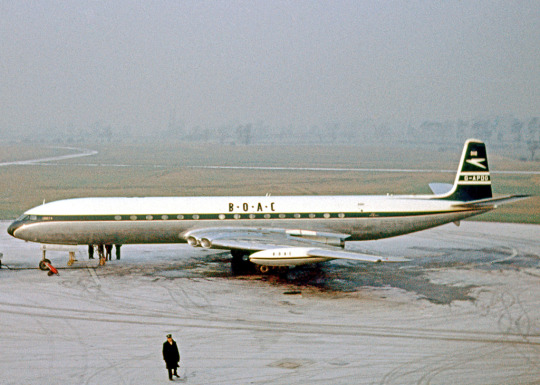
image: RuthAS
Okay, I'll show it, but I don't think it needs any further comment.
There's only one BOAC livery that was really recognizable a BOAC livery. It was still fairly boring. More like BOA(rin)C(g). (That one needs work.)
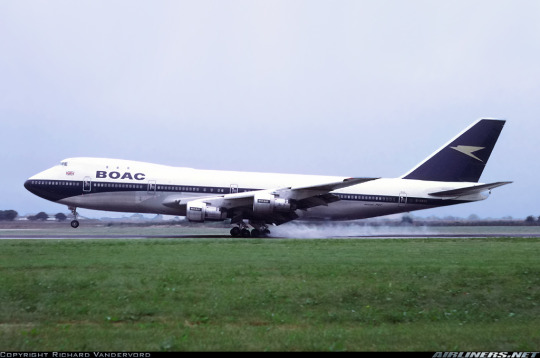
The only interesting thing about the BOAC livery, to me, is the way that sort of face mask shape combined with the tail almost gives it a sort of diagonal symmetry - the front with a blue dip below the white center, the end with a peak above it. It is a very efficient and deceptively effective, potentially unintentionally, use of geometry. I also appreciate the restraint of sticking to blue and white and leaving out red. The minimal nature of it increases the geometric feeling, really saving this livery from my complete disdain. The speedbird logo is really well-centered on the tail, feeling almost like a diagonal slash cut right through it, and I like the use of greyish gold instead of white, which makes it appear less jarring while still being clearly visible. For its day, these positives are certainly not to be fully ignored, though saying that this is a pretty alright 60s white-and-blue cheatline livery is not that high of a compliment. It is cleanly done but in no way exceptional, with a neat bit of art deco angularity to it that you really only notice if you stare at pictures of airplanes as a hobby.
On the other hand, it has a nothing wordmark that honestly just irritates me by breaking up that big clean white block in the same way an old scratch breaks up the flatness of an iPhone screen and it does that thing I hate where a cheatline sort of just...trails off under the tailplane that a fair number of 747 liveries do. It feels like they just couldn't think of anything to do with the end of the plane, which is never what you want from a livery, especially not from an airline that takes itself as seriously as BOAC did. It also uses the isolated tail block, which is a design feature I dislike. At least the extreme matteness of BOAC's midnight-blue-on-white makes it a bit less awful, and the white forward trim is a nice touch.
On balance, I'll give it a BOAC-. That is referring, of course, to the face mask livery, which I think is straddling the fence between 'adequate' and 'forgettable'. I truly have so little to say about the earlier liveries that I'm not going to even give them a grade.

The BOAC livery briefly flew again in 2019 (which British Airways claims to be centenary based on the foundation of Aircraft Transport and Travel, except I've mainly seen that said to be 1916 and most people's consensus is that British Airways was founded in 1974 and no earlier) when it was painted on the 747-400 registered G-BYGC. She was the last 747 to fly for British Airways, just a year after the livery was applied, and there were plans to preserve her in the heritage livery which never materialized. Sadly, she was scrapped in late 2023.
But there was that speedbird on the tail! The speedbird was so damn iconic that it was even BOAC's callsign. So where did it go?
We'll get to that. There's more to British Airways than BOAC.
BOAC was state-owned, and it held a place of national prominence...so it was the flag carrier, right?
Sort of. It was a flag carrier. BOAC was the UK's Pan Am, specializing in long-distance international flights (hence 'overseas' in the name). There was also British South American Airways, a short-lived national carrier which was absorbed into BOAC after two years, with its most notable contributions to history being the disappearances of its planes Star Tiger and Star Ariel, but a significantly more enduring brand was BEA.
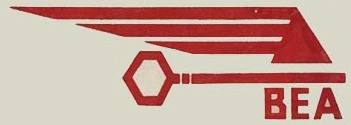
This initial logo, also the work of Theyre Lee-Elliott, had a key motif to accompany BEA's slogan, 'the key to Europe'. I adore it. I like BEA a lot.
While initially founded as an offshoot of BOAC (which I suppose was the singular flag carrier from 1939 to 1946), British European Airways Corporation specialized in, as the name implied, flights within Europe (and other relatively nearby destinations). It was something of a VASP-and-VARIG situation. Nobody ever called it BEAC, though, even though it sounds like 'beak' and birds are a whole thing, because...flying...well, look, we can all understand, in retrospect, that one of the great tragedies of aviation history is that I wasn't there to have ideas. That said, maybe it's a good thing I never planted this seed, because their callsign was BEALINE, which is...just the most adorable thing I think I've ever heard. It genuinely makes me smile. It may be my favorite ever callsign.

They did eventually change their official name to just British European Airways. Sort of a shame, if you ask me - you could have been twinsies. Ah, well. Also a shame is the perplexing choice to shelve their rather nice and meaningful original logo and replace it with what I can generously describe as 'a square' in 1957. I think SAS did it better. I can't rule out that I just hate it because the old one was so much better, though. I've seen far uglier, but again - this is a square.

image: Adrian Pingstone
When it's on the livery, it's not even well-aligned! And it's difficult to imagine negotiating this onto an aircraft tail, even when dealing with a generously square fin like the Trident's. (BEA loved their Tridents, which were essentially designed for the airline's operations, and operated 70 of the 117 airframes completed. This makes me like them, because I love the Trident too.) That said, I think that if you're using a logo that is just the name of your airline, putting it on the tail rather than the front side fuselage is a bold move. Today it rarely pays off, but in the era of cheatlines and half-bare planes it actually avoids the issues of legibility and vertical space that a lot of other contemporary liveries struggled with.
Still, the square. It will simply never not look strange to have two straight vertical lines on a fin that's more or less diagonal to them, and I'm not sure how that could be fixed. They did the best they could, I think, but this was just doomed from the start.
On the other hand, I do enjoy its placement within the cheatline. It helps keep a sense of pace but doesn't break up the line, and it just feels like it clicks into place in a way I love. I like the continuity with the black line at the tip of the horizontal stabilizer, and I like that the white paint doesn't extend down as far as on a lot of liveries of the time, leaving the cheatline to taper above the Trident's rear-mounted engines instead of underlying them as many other airlines' did.
This logo and livery were designed by Mary de Saulles, who was trained as an architect rather than a graphic designer. I think it shows in the very simple shapes and lines present here, and it also shows in the fact that despite it technically not doing anything too unusual the BEA livery was very distinctive when actually on the apron.
BEA's liveries weren't terribly more innovative than BOAC's at first glance. But their black-and-red 60s livery was actually, deceptively, a standout of the era.


images: Ralf Manteufel | Adrian Pingstone
The red wings on BEA's aircraft were absurdly stylish. There are dozens of reasons involving weight and heat and aerodynamic properties that prevent airlines from painting the wings on their airliners anything but a very dull drab, and I despise it, but when even the all-black Air New Zealand plane has white wings it begins to feel like it's just not possible to do anything else. Actually, it is hypothetically possible, though expensive, as long as you avoid the leading edges, though I'm sure the margins for shape and weight of a wing are far more precise on a 787 than they were on a Viscount. Still, I can't help but wish airlines would swallow the costs of painting wings (not like liveries aren't already a needless expense if you're trying to really optimize), because just look at this. It's absolutely stunning. It brings BEA's livery all the way from completely forgettable to by far the most eye-catching in the approach pattern.
And, you know what? I'll give them a BEA for that.
It might seem like a bit of a strange evaluation when I spent two paragraphs complaining about that square, but just imagine being on the ground and seeing a Comet landing, the lack of underwing pylons leaving that big red wing, like the lining of a cloak. That's a real Riyadh Air first impression. So while yes, the square is a square and certain aspects of the livery's implementation on various models range from forgettable to clunky, I am disregarding all of that, because this is like Dracula showing up to a board meeting. They are literally flying Louboutins.
BEA's livery and branding evolved over time in a way BOAC just didn't. BOAC never had anything I would identify as a 'rebranding' - it sprang fully formed from the Queen's (or something) head and stayed in its pristine state until the day it abruptly vanished. This was not quite the case for BEA.

image: Adrian Pingstone
This is a preserved airframe, hence the very anachronistic car models in the foreground. Still, the livery is accurate.
Their final livery, introduced 1968, was this - the 'speedjack' livery. The speedjack is, more specifically, that delightfully pointed Union Jack emblem on the tail. I do like the speedjack itself, being one of the only decent uses of a Union Jack base I've ever seen. It feels obvious yet brilliant to turn the intersecting lines of the flag into an arrow shape. Unfortunately, far more was changed than just the logo.
My beloved flying Louboutin was gone. They still sometimes had the red wings at this point, but in every other way it was a new livery. I actually find that something is lost here, because the old BEA livery had red but not blue, and the BOAC livery had blue but not red, so they were sort of a matching set. Also, um, that wordmark is legitimately hideous.

It's a bit less horrible when it's not red letters on a white background, at least. And it does have a forward slant, a continuity...but this lacks the brilliance of Lee-Elliott's key or the charm of the de Saulles square.
The speedjack, logo, and livery were created by FHK Henrion, whose work has appeared on this blog before, though I failed to mention it. He designed the KLM crown logo!
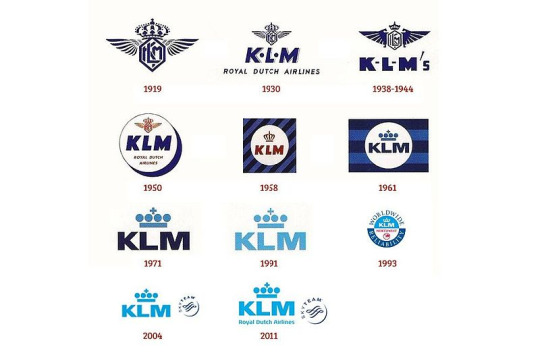
...a logo I used to think was fine until learning about the absolute beauty they had from 1930 to 1938. Henrion designed the totally palatable 1961 version, and further modifications were made by the firm Henrion, Ludlow & Schmidt, with at least the 1991 change being the work of Ludlow. It's certainly gone downhill, but maybe I just think that because of how much I adore the 1930 iteration.
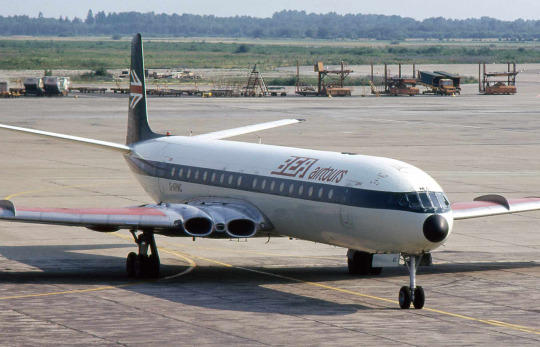
image: Piergiuliano Chesi
As for BEA - at the very least they kept the red wings. This is sort of a double-edged sword, though. This livery was, overall, far less distinct from its surroundings than the de Saulles livery, and the addition of the lighter blue to the fuselage really dulls the impact of the red against the stark black it used to share the airframe with. It just feels...flat. Neutered. Like an interim livery when one airline has bought out another and the paint jobs are changed out piecemeal. (And I think a red-only speedjack on a black tail would look fantastic, for the record.)
The details aren't much better. The cheatline feels almost too thin for the cockpit windows and the tiny wordmark makes the white fuselage feel as empty as it is without the little BEA logos making sure that isn't what you're focused on. Some models, like the Trident Three and Super One-Eleven, get their status indicated by text on the tail that looks like the default font of a word processor. It's just sloppy. Henrion's effort went to the speedjack, where a firm which specializes in image identity generally would be directed, and some interest was taken in the wordmark, but the livery itself feels like a pieced-together afterthought.
This gets a grade of...please just go back. I want to say D+.
How much of that grade comes from genuine dislike of the Henrion livery versus just thinking it's worse than what came before, I don't know, but it's one of the most immediate downgrades I've ever seen and the attempt to keep the most striking feature of the old livery while sapping it of its power feels almost insulting. It feels messy and pieced-together, and it's angling dangerously close to having the same approximate color layout as the old SAS livery - you know, the only thing that's ever failed the Star Alliance Test.

And, at least from the side, and from farther away, it really doesn't fail the Star Alliance Test. It's serviceable, and I wouldn't be nearly this harsh on it if I didn't know what came before. But I've committed to a chronology of what would become British Airways, so I have to mention both, and that includes looking at them, reading about their design processes, and forming detailed opinions of them. This livery was just doomed by its predecessor.

Even British Airways seems to agree with me, given that when they painted an A319 (G-EUPJ) in a BEA retro livery they chose the older black-and-red. Some liveries are simply iconic. Some simply aren't.
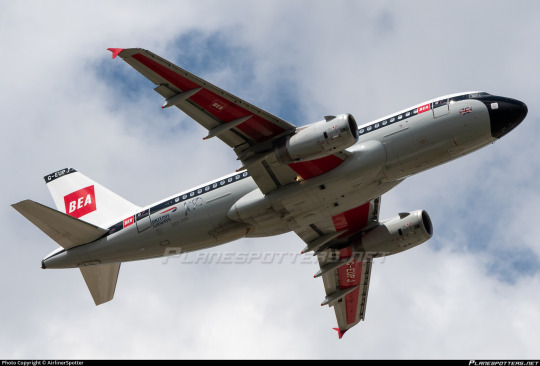
And, yes - the wings are red. At least, the bottom is. The top was forced to remain grey for reasons of 'reflectivity', which is fairly vague. Still, this should be a sign to other airlines - your planes will make an impression from below, and that impression could be as powerful as the one BEA used to make.
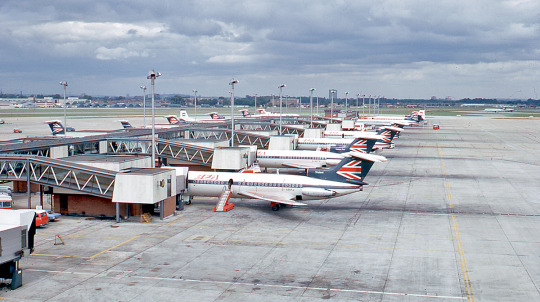
image: Ben Brooksbank
BEA, at its height, flew more passengers than any other airline in Europe. It had subsidiaries, including...Cyprus Airways. (Yes, the same one that's still the flag carrier of Cyprus. That's its own story.) They even operated helicopters.
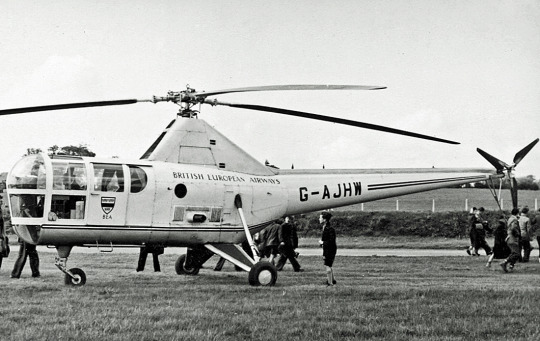
image: RuthAS
Cursed? You decide.
And then, as the 70s began, the decision was made to merge the two state-owned airlines - something which I would personally have done earlier, and apparently people did try to do earlier but were prevented from doing by...politics. You know, just a couple people with titles that begin with 'Secretary of' passive-aggressively fighting over financial things. In 1974, what was probably inevitable finally became a reality.
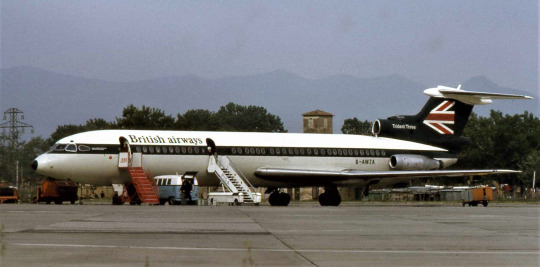
image: Piergiuliano Chesi
It takes a while to repaint a full airframe. When two airlines merge the change is often done bit by bit, making sure the wordmark's right but not bothering with the rest. In 1975, G-AWZA, pictured here, still wore the speedjack, but the wordmark above her cheatline said something new entirely, and a new airline was using the callsign SPEEDBIRD.

And this is where I will conclude today, thwarted by image limit. Of course, being the person I am, I couldn't help but make my return for the new year not just a two-parter but a three-parter. Having dispensed with the British Airwayses that weren't British Airways, part two will cover the British Airways of the surprisingly recent past.
In the meantime thank you to all readers, old and new. I'm thrilled to be back from my break, and I hope you'll stick around for another year of Runway Runway.
#tarmac fashion week#region: west/central europe#region: united kingdom#grade: a#grade: c-#grade: d+#british airways#british european airways#boac#double sunrise#era: 1950s#era: 1960s#era: 1970s#klm royal dutch airlines#imperial airways#long haul
34 notes
·
View notes
Text
Moth of the Week
Chimney Sweeper
Odezia atrata

The chimney sweeper is a part of the family Geometridae. It belongs to a monotypic genus, meaning it’s the only moth species in the genus Odezia, which was created in 1840 by Jean Baptiste Boisduval. It was first described in 1758 by Carl Linnaeus.
Description This moth is mostly black with white on the tips of the forewing (called the “apex”) and on the fringe of the forewing.
There have been a few variations in color:
- Odezia atrata pyrenaica, which is found in Pyrenees and central Italy, the wings are “dusted” in a brownish yellow with a stronger color on the forewing.
- Ab. Odezia atrata nigerrima, described by Paul Thierry-Mieg, was a female with no white apex or fringe.
- This moth’s wings may become brown from wear over time.
Wingspan Range: 23–27 mm (≈0.91 - 1.06 in)
Forewing Range: 12–15 mm (≈0.47 - 0.59 in)
Diet and Habitat The caterpillars of this species mainly eats the flowers and seeds of pignut (Conopodium majus).
This moth is distributed in the Palearctic region. In the west, it’s range reaches the Iberian Peninsula through western and central Europe and the British Isles. In the east, they can be found in Sakhalin and the Amur-Ussuri region. I’m the north, this moth reaches central Fennoscandia. Finally, in the south they are found in Italy to the Balkans.
These moths were once very common in Austria, but now the species is a rare occurrence.
They inhabit ditch edges, meadows, bogs, moors, lake sides, chalk downland, limestone grassland, woodland edges and hedgerows in southern Britain
Mating In Belgium and the Netherlands this moth can be seen flying from June to August. It presumably Nate’s during this timeframe.
Predators This moth flies during the day, especially in sunshine. They are presumably preyed on by birds and other daytime predators.
Fun Fact The chimney sweeper can be confused for the Small Blue butterfly (Cupido minimus), which also lives in the Palearctic region, as its wings may become brown from wear.
(Source: Wikipedia, Butterfly Conservation)
#libraryofmoths#animals#bugs#insects#moth#lepidoptera#facts#mothoftheweek#Odezia atrata#Chimney Sweeper#Geometridae#late post#sorry!
137 notes
·
View notes
Text
Who Were the "Hessians"?
A good article from Facebook by Dr Alex Burns;
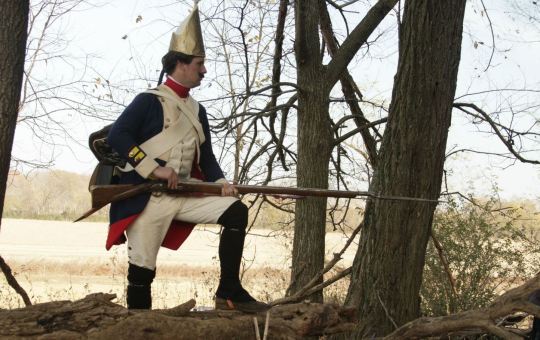
Myth 1): German troops were all Hessians.
Although most came from the mid-sized German state of Hessen-Kassel, troops from six different principalities (Hessen-Kassel, Braunschweig-Wolfenbüttel, Hessen-Hanau, Ansbach-Bayreuth, Waldeck, and Anhalt-Zerbst.) Indeed, the current leading progressive reenactment group portraying these soldiers represents Regiment Prinz Friedrich, essentially a garrison unit from Braunschweig-Wolfenbüttel.
If you include the larger, global war outside America, fought in places like Gibraltar and India, troops from the state of Hanover (Braunschweig-Lüneburg) also fought for the British outside of the Holy Roman Empire (the pre-German territorial entity.) So, while over 60% of these troops came from Hessen, they really hailed from all over the western and central Holy Roman Empire. As a result, it might be better to call them something other than Hessians. "Germanic" has been put forward, but that usually conjures up images of the fall of the Western Roman Empire.
Myth 2): They were mercenaries.
Imagine you are a soldier in the United States Army, serving in West Germany during the Cold War. You are stationed there because of longstanding agreements and alliances, which stretch back decades. The United States Government and the West German government have a financial understanding that helps maintain your presence in the region. Are you a mercenary? The situation was very similar for the German-speaking soldiers who fought in the American War of Independence, They had a longstanding relationship with Great Britain, stretching back decades. They had fought with alongside the British since the 1690s, both in continental Europe and in the British isles. As a result of the Hanoverian succession in 1714 (the British Royal family was drawn from Hanover) they had longstanding marriage connections with Great Britain. Horace Walpole, a British politician from the 1730s, referred to the Hessians as the Triarii of Great Britain.
These soldiers did not personally or corporately take on contracts from the British. they were members of state militaries: their governments were paid a subsidy by the British in order to fight in their wars. Frederick II (the Great) of Prussia, received subsidies from the British during the Seven Years War. As a result, the modern German term for these troops is *Subsidientruppen, *or subsidy troops. **Thus, it might be better to speak of the German-speaking subsidy troops, as opposed to calling them Hessians, or mercenaries. **Historians have argued that it might be fitting to call their countries "mercenary states". This is different from saying they were mercenaries.
Myth 3): They were sold to America because their princes were greedy and wanted to build palaces and pay for their illegitimate children.
The princes of the Western Holy Roman Empire lived in an incredibly dangerous world during the eighteenth century. Their territories were small, rural, principalities, trapped between the military giants of France, Austria, and Prussia. As a result, from the 1670s, these princes attempted to use subsidy contracts to build themselves larger armies, in order to preserve their independence. These subsidy contracts were a standard feature of European politics, diplomacy, and conflict resolution. They allowed the princes to better protect their small domains. None of the princes who formed subsidy contracts with Britain during the American War of Independence were doing something radically new or greedy. Instead, they were following on decades of practice which had allowed them to maintain their own independence. The Hessian (Hessen-Kassel) Landgraf Friedrich II actually used the funds from the contract, in part, to promote economic development and the textile industry in his territories. **Some of them had illegitimate children. Some had palaces. Portraying them as sex-crazed misers limits our understanding of the economic and security necessities which actually underpinned their subsidy policies. **Following the long-standing practices of their governments, princes in the Western Holy Roman Empire entered subsidy agreements to maintain the costs of their states.
Myth 4): They committed many brutal war-crimes in America.
The subsidy troops had been used in messy civil conflicts before. Hessian troops were used against the Jacobites in 1745-6, where they remarkably refused to take part in the repression against the Scottish Jacobites. Their troops were remembered in Perthshire, Scotland, as "a gentle race," and their commanding Prince (Friedrich II) declared, "My Hessians and I have been called to fight the enemies of the British crown, but never will we consent to hang or torture in its name." (Duffy, *Best of Enemies, *p. 133). English officers in the Seven Years War, noted that their troops were reprimanded for plundering more than Hessian forces. (Atwood, *The Hessians, *p. 173). In North America during the War of Independence, the Hessians once again behaved better than their British counterparts. Although there was a surge of fear about Hessian brutality early in the war, after the first few years of the war, Americans believed that the Hessians treated them better than British soldiers. Aaron Burr wrote of Hessian atrocities: "Various have been the reports concerning the barbarities committed by the Hessians, most of them [are] incredible and false." (Matthew Davis, *Memoirs of Aaron Burr, *Vol 1. p. 107). Comparing the brutality of the Napoleonic Wars with the American War of Independence, a Hessian veteran who served in both wars commented: "Everything which the author has subsequently seen in this regard greatly exceeds what one should term cruelty in America, which in comparison with more recent times, can be regarded as nothing more than a harmless puppet show." (Adam Ludwig von Ochs, *Betrachtungen Ueber die Kriegkunst, *60-61.) Hessian troops committed crimes in America, there is no doubt. What is clear is that these crimes were not excessive for an eighteenth-century conflict.
Myth 5): Many of them deserted to America, where life was better.
Many Americans claim Hessian ancestry. As a result, it is common to encounter the sentiment that these "mercenary" troops were simply waiting to switch sides. In reality, most of these troops returned to their homelands in the Holy Roman Empire. A very small number switched sides before the end of the war, a larger (but still small) percentage elected to remain in America after the war ended in 1783. Far from being an act of rebellion, the princes encouraged their subsidy troops to remain in America if they desire: this would cut costs, and make the process of slashing the military budget easier in peacetime. Most returned to celebrations, public parades, and being welcomed by loved ones. For more on exact data of desertions, as well as the subsidy-troops' return home, see Daniel Krebs' book, *A Generous and Merciful Enemy. *The majority of these troops remained loyal to their princes, and returned home to their own native lands.
Who Were the Hessians?
The experience of 37,000 soldiers mainly drawn from six small counties is not all one thing. There are elements of truth to each of the myths about the Hessians, but their story is more complex than the myths that are told about them in English-speaking circles in North America. They were drawn from a fascinating world in Central Europe with its own customs, practices, and traditions. They entered the American story, and as a result, it is worth taking the time to understand and remember their path in it in a complex way.
A "Hessian" Reading List:
Rodney Atwood: "The Hessians: Mercenaries from Hessen-Kassel in the American Revolution"
Friedrike Baer: "Hessians: German Soldiers in the American Revolutionary War"
Stephan Huck: "Soldaten gegen Nordamerika Lebenswelten Braunschweiger Subsidientruppen im amerikanischen Unabhängigkeitskrieg"
Charles Ingrao: "The Hessian Mercenary State: Ideas, Institutions, and Reform under Frederick II, 1760–1785"
Daniel Krebs: "A Generous and Merciful Enemy: Life for German Prisoners of War during the American Revolution"
#history#military history#18th century#american revolution#revwar#american war of independence#hessian#hessians#german
126 notes
·
View notes
Text





The European Wild Cat (Felis sylvestris sylvestris) is a small feline species currently re-populating vast areas of Germany. Its population is distributed over large areas of Southern and Central Europe from the far west to Ukraine and the Caucasus. It is absent in Northern Europe. After a dramatic drop of the population in the late 19th and early 20th century, which led to a complete disappearance in many regions and entire countries, the population and inhabited areas are constantly expanding again. Today's population is probably vastly underestimated due to the elusive lifestyle. New finds in an area are often made by chance on camera traps. The species has reappeared in Switzerland and Austria in the recent years and is reclaiming forests in Southern and Central Germany. The sharp decline in population was formerly attributed to intense hunting, but paleo-veterinarian investigations found evidence for an epidemic event as the likely cause.
In Germany, the cat prefers to live in large forests with little disturbances. This has led to the assessment that an undisturbed and unmanaged forest with the general absence of humans is required as a habitat for these cats. However, this assessment has come under debate as in Southern Europe, the European Wild Cat lives in more densely populated areas in close proximity to settlements. Camera traps in Germany have shown European Wild Cats living in relative proximity to human settlements. In addition, contrary to former belief, the existence of wide roads is not a major obstacle for the migration and the re-population of habitats. Nevertheless, Germany with its large forested areas provides ideal habitat for the European Wild Cat.
The European Wild Cat is similar in appearance to the common domestic cat, but its body is bigger, more massive, with taller legs and a head that accommodates a bigger brain. In contrast to the domestic cat, the European Wild Cat is regarded as being indomitable.
The status of The European Wild Cat and the domestic cat as two separate species (Felis silvestris and Felis catus, respectively – Felis catus originating fro Felis lybica, the African Wildcat) as defined by IUCN is debated among zoologists, as individuals of both taxonomical units can have viable and fertile offspring, which is usually results in assigning them as subspecies of the same species (Felis sylvestris sylvestris and Felis sylvestris lybica, respectively). Hybrids of Felis sylvestris and Felis catus also occur in nature, which leads among conservationists to the concern that pure-breed Felis sylvestris will die out in the future due to bastardization.
177 notes
·
View notes
Text
Countries that are no more: Achaemenid Empire (550BC-330BC)
It was not the first empire of Iranian peoples, but it arose as probably the greatest in terms of influence and became the measure by which all subsequent Iranian empires tended to compare themselves and its influence on culture, government & civil infrastructure would influence others beyond the span of its territory and the span of time. This is the Achaemenid Empire.
Name: In Old Persian it was known as Xšāça or the "The Kingdom or the Empire", it was named the Achaemenid Empire by later historians. Named after the ruling dynasty established by its founder Cyrus the Great who cited the name of his ancestor Haxāmaniš or Achaemenes in Greek as progenitor of the dynasty. It is sometimes also referred to as the First Persian Empire. The Greeks simply referred to it as Persia, the name which stuck for the geographic area of the Iranian plateau well into the modern era.
Language: Old Persian & Aramaic were the official languages. With Old Persian being an Iranian language that was the dynastic language of the Achaemenid ruling dynasty and the language of the Persians, an Iranian people who settled in what is now the southwestern Iranian plateau or southwest Iran circa 1,000 BC. Aramaic was a Semitic language that was the common and administrative language of the prior Neo-Assyrian & Neo-Babylonian Empires which centered in Mesopotamia or modern Iraq, Syria & Anatolian Turkey. After the Persian conquest of Babylon, the use of Aramaic remained the common tongue within the Mesopotamian regions of the empire, eventually becoming a lingua franca across the land. As the empire spread over a vast area and became increasingly multiethnic & multicultural, it absorbed many other languages among its subject peoples. These included the Semitic languages Akkadian, Phoenician & Hebrew. The Iranian language of Median among other regional Iranian languages (Sogdian, Bactrian etc). Various Anatolian languages, Elamite, Thracian & Greek among others.
Territory: 5.5 million kilometers squared or 2.1 million square miles at its peak circa 500BC. The Achaemenid Empire spanned from southern Europe in the Balkans (Greece, Bulgaria, European Turkey) & northwest Africa (Egypt, Libya & Sudan) in the west to its eastern stretches in the Indus Valley (Pakistan) to parts of Central Asia in the northeast. It was centered firstly in the Iranian Plateau (Iran) but also held capitals in Mesopotamia (Iraq). Territory was also found in parts of the Arabian Peninsula & the Caucausus Mountains.
Symbols & Mottos: The Shahbaz or Derafsh Shahbaz was used as the standard of Cyrus the Great, founder of the empire. It depicts a bird of prey, typically believed to be a falcon or hawk (occasionally an eagle) sometimes rendered gold against a red backdrop and depicts the bird holding two orbs in its talons and adorned with an orb likewise above its head. The symbolism was meant to depict the bird guiding the Iranian peoples to conquest and to showcase aggression & strength coupled with dignity. The imperial family often kept falcons for the pastime of falconry.
Religion: The ancient Iranian religion of Zoroastrianism served as the official religion of the empire. It was adopted among the Persian elite & and had its unique beliefs but also helped introduce the concept of free-will among its believers, an idea to influence Judaism, Christianity & Islam in later centuries. Despite this official religion, there was a tolerance for local practices within the subject regions of the empire. The ancient Mesopotamian religion in Babylon & Assyria, Judaism, the Ancient Greek & Egyptian religions & Vedic Hinduism in India was likewise tolerated as well. The tolerance of the Achaemenids was considered a relative hallmark of their dynasty from the start. Famously, in the Old Testament of the Bible it was said that it was Cyrus the Great who freed the Jews from their Babylonian captivity and allowed them to return to their homeland of Judea in modern Israel.
Currency: Gold & silver or bimetallic use of coins became standard within the empire. The gold coins were later referred to as daric and silver as siglos. The main monetary production changes came during the rule of Darius I (522BC-486BC). Originally, they had followed the Lydian practice out of Anatolia of producing coins with gold, but the practice was simplified & refined under the Achaemenids.
Population: The estimates vary ranging from a low end of 17 million to 35 million people on the upper end circa 500BC. The official numbers are hard to determine with certainty but are generally accepted in the tens of millions with the aforementioned 17-35 million being the most reasonable range based on available sources.
Government: The government of the Achaemenid Empire was a hereditary monarchy ruled by a king or shah or later referred to as the ShahanShah or King of Kings, this is roughly equivalent to later use of the term Emperor. Achaemenid rulers due the unprecedented size of their empire held a host of titles which varied overtime but included: King of Kings, Great King, King of Persia, King of Babylon, Pharaoh of Egypt, King of the World, King of the Universe or King of Countries. Cyrus the Great founded the dynasty with his conquest first of the Median Empire and subsequently the Neo-Babylonians and Lydians. He established four different capitals from which to rule: Pasargadae as his first in Persia (southwest central Iran), Ecbatana taken from the Medians in western Iran's Zagros Mountains. The other two capitals being Susa in southwest Iran near and Babylon in modern Iraq which was taken from the Neo-Babylonians. Later Persepolis was made a ceremonial capital too. The ShahanShah or King of Kings was also coupled with the concept of divine rule or the divinity of kings, a concept that was to prove influential in other territories for centuries to come.
While ultimate authority resided with the King of Kings and their bureaucracy could be at times fairly centralized. There was an expansive regional bureaucracy that had a degree of autonomy under the satrapy system. The satraps were the regional governors in service to the King of Kings. The Median Empire had satraps before the Persians but used local kings they conquered as client kings. The Persians did not allow this because of the divine reverence for their ShahanShah. Cyrus the Great established governors as non-royal viceroys on his behalf, though in practice they could rule like kings in all but name for their respective regions. Their administration was over their respective region which varied overtime from 26 to 36 under Darius I. Satraps collected taxes, acted as head over local leaders and bureaucracy, served as supreme judge in their region to settle disputes and criminal cases. They also had to protect the road & postal system established by the King of Kings from bandits and rebels. A council of Persians were sent to assist the satrap with administration, but locals (non-Persian) could likewise be admitted these councils. To ensure loyalty to the ShahanShah, royal secretaries & emissaries were sent as well to support & report back the condition of each satrapy. The so called "eye of the king" made annual inspections of the satrapy to ensure its good condition met the King of Kings' expectations.
Generals in chief were originally made separate to the satrap to divide the civil and military spheres of government & were responsible for military recruitment but in time if central authority from the ShahanShah waned, these could be fused into one with the satrap and general in chiefs becoming hereditary positions.
To convey messages across the widespread road system built within the empire, including the impressive 2,700 km Royal Road which spanned from Susa in Iran to Sardis in Western Anatolia, the angarium (Greek word) were an institution of royal messengers mounted on horseback to ride to the reaches of the empire conveying postage. They were exclusively loyal to the King of Kings. It is said a message could be reached to anywhere within the empire within 15 days to the empire's vast system of relay stations, passing message from rider to rider along its main roads.
Military: The military of the Achaemenids consisted of mostly land based forces: infantry & cavalry but did also eventually include a navy.
Its most famous unit was the 10,000-man strong Immortals. The Immortals were used as elite heavy infantry were ornately dressed. They were said to be constantly as 10,000 men because for any man killed, he was immediately replaced. Armed with shields, scale armor and with a variety of weapons from short spears to swords, daggers, slings, bows & arrows.
The sparabara were the first line of infantry armed with shields and spears. These served as the backbone of the army. Forming shield walls to defend the Persian archers. They were said to ably handle most opponents and could stop enemy arrows though their shields were vulnerable to enemy spears.
There was also the takabara light infantry and though is little known of them it seems they served as garrison troops and skirmishers akin to the Greek peltast of the age.
The cavalry consisted of four distinct groups: chariot driven archers used to shoot down and break up enemy formations, ideally on flat grounds. There was also the traditional horse mounted cavalry and also camel mounted cavalry, both served the traditional cavalry functions and fielded a mix of armor and weapons. Finally, there was the use of war elephants which were brought in from India on the empire's eastern reaches. These provided archers and a massive way to physically & psychologically break opposing forces.
The navy was utilized upon the empire's reaching the Mediterranean and engaged in both battles at sea and for troop transport to areas where troops needing deploying overseas, namely in Greece.
The ethnic composition of Achaemenid military was quite varied ranging from a Persian core with other Iranian peoples such as the Medians, Sogdian, Bactrians and Scythians joining at various times. Others including Anatolians, Assyrians, Babylonians, Anatolians, Indians, Arabs, Jews, Phoenicians, Thracians, Egyptians, Ethiopians, Libyans & Greeks among others.
Their opponents ranged from the various peoples they conquered starting with the Persian conquest of the Medians to the Neo-Babylonians, Lydians, Thracians, Greeks, Egyptians, Arabs & Indians and various others. A hallmark of the empire was to allow the local traditions of subjugated areas to persist so long as garrisons were maintained, taxes were collected, local forces provided levies to the military in times of war, and they did not rebel against the central authority.
Economy: Because of the efficient and extensive road system within the vast empire, trade flourished in a way not yet seen in the varied regions it encompassed. Tax districts were established with the satrapies and could be collected with relative efficiency. Commodities such as gold & jewels from India to the grains of the Nile River valley in Egypt & the dyes of the Phoenicians passed throughout the realm's reaches. Tariffs on trade & agricultural produce provided revenue for the state.
Lifespan: The empire was founded by Cyrus the Great circa 550BC with his eventual conquest of the Median & Lydian Empires. He started out as Cyrus II, King of Persia a client kingdom of the Median Empire. His reign starting in 559BC. Having overthrown and overtaken the Medians, he turned his attention Lydia and the rest of Anatolia (Asia Minor). He later attacked the Eastern Iranian peoples in Bactria, Sogdia and others. He also crossed the Hindu Kush mountains and attacked the Indus Valley getting tribute from various cities.
Cyrus then turned his attention to the west by dealing with the Neo-Babylonian Empire. Following his victory in 539BC at the Battle of Opis, the Persians conquered the Babylonia with relative quickness.
By the time of Cyrus's death his empire had the largest recorded in world history up to that point spanning from Anatolia to the Indus.
Cyrus was succeeded by his sons Cambyses II and Bardiya. Bardiya was replaced by his distant cousin Darius I also known as Darius the Great, whose lineage would constitute a number of the subsequent King of Kings.
Darius faced many rebellions which he put down in succession. His reign is marked by changes to the currency and the largest territorial expansion of the empire. An empire at its absolute zenith. He conquered large swaths of Egypt, the Indus Valley, European Scythia, Thrace & Greece. He also had exploration of the Indian Ocean from the Indus River to Suez Egypt undertaken.
The Greek kingdom of Macedon in the north reaches of the Hellenic world voluntarily became a vassal of Persia in order to avoid destruction. This would prove to be a fateful first contact with this polity that would in time unite the Greek-speaking world in the conquest of the Achaemenid Empire. However, at the time of Darius I's the reign, there were no early indications of this course of events as Macedon was considered even by other Greek states a relative backwater.
Nevertheless, the Battle of Marathon in 490BC halted the conquest of mainland Greece for a decade and showed a check on Persia's power in ways not yet seen. It is also regarded as preserving Classical Greek civilization and is celebrated to this day as an important in the annals of Western civilization more broadly given Classical Greece & in particular Athens's influence on western culture and values.
Xerxes I, son of Darius I vowed to conquer Greece and lead a subsequent invasion in 480BC-479BC. Xerxes originally saw the submission of northern Greece including Macedon but was delayed by the Greeks at the Battle of Thermopylae, most famously by Spartan King Leonidas and his small troop (the famed 300). Though the Persians won the battle it was regarded as a costly victory and one that inspired the Greeks to further resistance. Though Athens was sacked & burnt by the Persians, the subsequent victories on sea & land at Salamis & Plataea drove the Persians back from control over Greece. Though war would rage on until 449BC with the expulsion of the Persians from Europe by the Greeks.
However, the Greeks found themselves in a civil war between Athens & Sparta and Persia having resented the Athenian led coalition against their rule which had expelled them from Europe sought to indirectly weaken the Greeks by supporting Greek factions opposed to Athens through political & financial support.
Following this reversal of fortune abroad, the Achaemenid Empire not able to regain its foothold in Europe, turned inward and focused more on its cultural development. Zoroastrianism became the de-facto official religion of the empire. Additionally, architectural achievements and improvements in its many capitals were undertaken which displayed the empire's wealth. Artaxerxes II who reigned from 405BC-358BC had the longest reign of any Achaemenid ruler and it was characterized by relative peace and stability, though he contended with a number of rebellions including the Great Satraps Revolt of 366BC-360BC which took place in Anatolia and Armenia. Though he was successful in putting down the revolt. He also found himself at war with the Spartans and began to sponsor the Athenians and others against them, showcasing the ever dynamic and changing Greco-Persian relations of the time.
Partially for safety reasons, Persepolis was once again made the capital under Artaxerxes II. He helped expand the city and create many of its monuments.
Artaxerxes III feared the satraps could no longer be trusted in western Asia and ordered their armies disbanded. He faced a campaign against them which suffered some initial defeats before overcoming these rebellions, some leaders of which sought asylum in the Kingom of Macedon under its ruler Philip II (father of Alexander the Great).
Meanwhile, Egypt had effectively become independent from central Achaemenid rule and Artaxerxes III reinvaded in around 340BC-339BC. He faced stiff resistance at times but overcame the Egyptians and the last native Egyptian Pharaoh Nectanebo II was driven from power. From that time on ancient Egypt would be ruled by foreigners who held the title Pharaoh.
Artaxerxes III also faced rebellion from the Phoenicians and originally was ejected from the area of modern coastal Lebanon, Syria & Israel but came back with a large army subsequently reconquered the area including burning the Phoenician city of Sidon down which killed thousands.
Following Artaxerxes III's death his son succeeded him but a case of political intrigue & dynastic murder followed. Eventually Darius III a distant relation within the dynasty took the throne in 336BC hoping to give his reign an element of stability.
Meanwhile in Greece, due to the military reforms and innovations of Philip II, King of Macedon, the Greek speaking world was now unified under Macedon's hegemony. With Philip II holding the title of Hegemon of the Hellenic League, a relatively unified coalition of Greek kingdoms and city-states under Macedon premiership that formed to eventually invade Persia. However, Philip was murdered before his planned invasion of Asia Minor (the Achaemenid's westernmost territory) could commence. His son Alexander III (Alexander the Great) took his father's reforms and consolidated his hold over Greece before crossing over to Anatolia himself.
Darius III had just finished reconquering some rebelling vestiges of Egypt when Alexander army crossed over into Asia Minor circa 334BC. Over the course of 10 years Alexander's major project unfolded, the Macedonian conquest of the Persian Empire. He famously defeated Persians at Granicus, Issus and Gaugamela. The latter two battles against Darius III in person. He took the King of Kings family hostage but treated them well while Darius evacuated to the far eastern reaches of his empire to evade capture. He was subsequently killed by one of his relatives & satraps Bessus, whom Alexander eventually had killed. Bessus had declared himself King of Kings though this wasn't widely recognized and most historians regard Darius III, the last legitimate ShahanShah of Achaemenids.
Alexander had taken Babylon, Susa & Persepolis by 330BC and effectively himself was now ruler of the Persian Empire or at least its western half. In addition to being King of Macedon & Hegemon of the Hellenic League, he gained the titles King of Persia, Pharaoh of Egypt & Lord of Asia. Alexander would in time eventually subdue the eastern portions of the Achaemenid realm including parts of the Indus Valley before turning back to Persia and Babylon where he subsequently became ill and died in June 323BC at age 32. Alexander's intentions it appears were never to replace the Achaemenid government & cultural structure, in fact he planned to maintain and hybridize it with his native Greek culture. He was in fact an admirer of Cyrus the Great (even restoring his tomb after looting) & adopted many Persian customs and dress. He even allowed the Persians to practice their religion and had Persian and Greeks start to serve together in his army. Following his death and with no established successor meant the empire he established which essentially was the whole Achaemenid Empire's territory in addition to the Hellenic world fragmented into different areas run by his most trusted generals who established their own dynasties. The Asian territories from Anatolia to the Indus (including Iran and Mesopotamia) gave way to the Hellenic ruled Seleucid Empire while Egypt became the Hellenic ruled Ptolemaic Kingdom. The synthesis of Persian and Greek cultures continued in the Seleucid and Greco-Bactrian kingdoms of antiquity.
The Achaemenid Empire lasted for a little over two centuries (550BC-330BC) but it casted a long shadow over history. Its influence on Iran alone has persisted into the modern age with every subsequent Persian Empire claiming to be its rightful successor from the Parthian & Sasanian Empires of pre-Islamic Iran to the Safavids of the 16th-18th century and the usage of the title Shah until the last Shah's ejection from power in the 1979 Islamic Revolution. Even the modern Islamic Republic of Iran uses Achaemenid imagery in some military regiments and plays up its importance in tourism and museums as a source of pride to Persian (Farsi) & indeed Iranian heritage. Likewise, its form of governance and the pushing of the concept of divine rights of kings would transplant from its Greek conquerors into the rest of Europe along with various other institutions such as its road & mail system, tax collection & flourishing trade. Its mix of centralized & decentralized governance. Its religious & cultural tolerance of local regions even after their conquest would likewise serve as a template for other empires throughout history too. The Achaemenid Empire served as a template for vast international & transcontinental empires that would follow in its wake & surpass its size & scope of influence. However, it is worth studying for in its time, it was unprecedented, and its innovations so admired by the likes of Alexander the Great and others echo into the modern era.
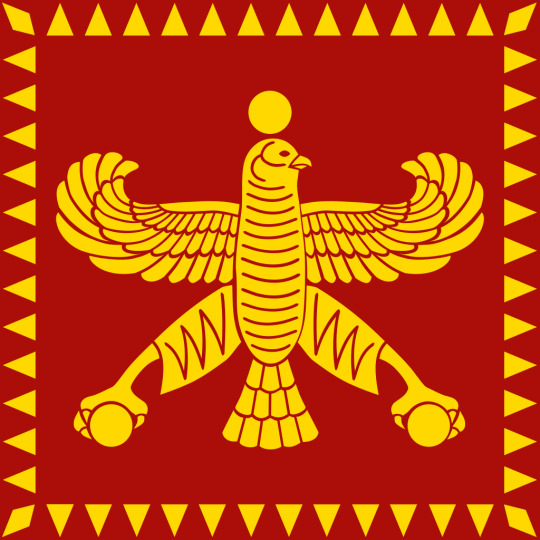
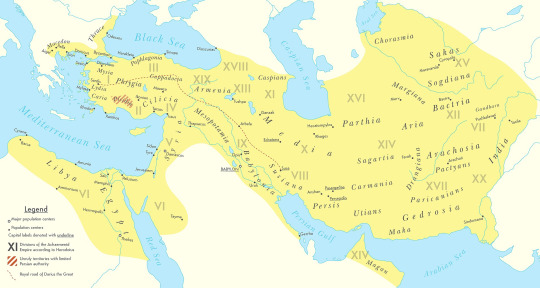


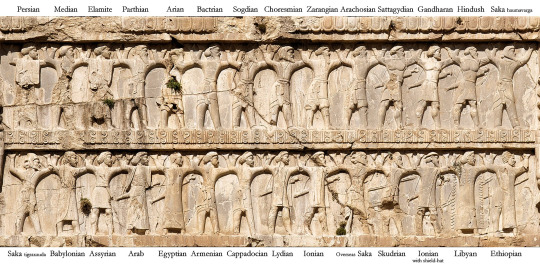
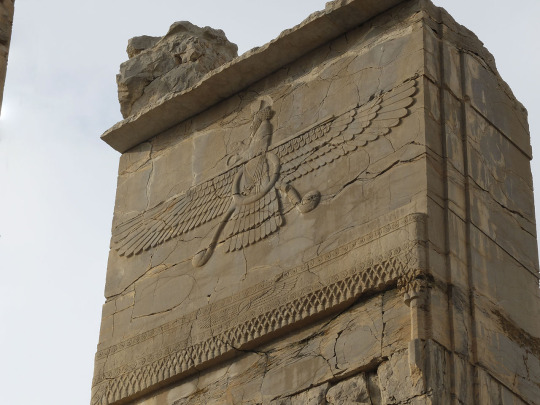




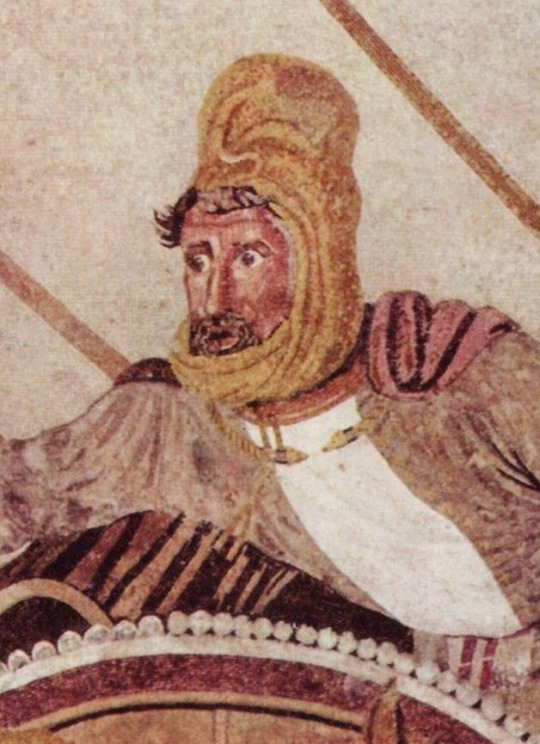
#military history#antiquity#iran#greece#ancient greece#classical greece#ancient ruins#ancient iran#ancient persia#achaemenid#persia#zoroastrianism#alexander the great#cyrus the great#xerxes#artwork#government#history#persian empire#ancient egypt
89 notes
·
View notes
Text
A collection of mini fun facts : I'll explain them base on the sequence of the geography (MAP)
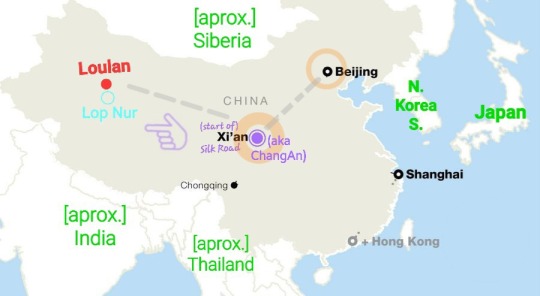
The CAPITALs : (orange circles)
Last time I talked about how palace in the anime take reference of Forbidden Palace, 🏛️ which is located in ☆Beijing, the capital city of Ming and Qing Dynasty.
However Xi'an🏛️ (aka ★ChangAn) is the capital city of TANG Dynasty,
which is the clothing style of the characters. (ChangAn is the ancient name of Xi'an)
FASHION :
During TANG, ★ChangAn, was a cosmopolitan and multicultural city since it is the starting destination of 🐫 Silk Road.

Ah Dou is wearing a riding suit, know as Hufu 👕. It was a fashion among the noble ladies to wear Hufu for horse ride🐴 . Hufu is male clothing of the *Western region (part of 🐫 Silk Road). [ *West is Central Asia, not Europe]

LOULAN : (red on map)
Maomao was curious of 💐Concubine Loulan who has Northen facial feature while wearing Southern outfit. In history, LouLan was the name of an ancient 👑kingdom at *Western region. It's location is modern Xinjiang near the now dried salt lake Lop Nur (MAP). The carved wooden beam above is an artifact of Loulan Kingdom.👑

NAIL POLISH :
Just as the anime, Balsam is a major ingredient for 💅nail polish (also for blush and lip color).

Balsam flowers are usually found in Central, East and South of Asia. When my grandma was a girl, she grounded the flower patels and apply them on nails then wait for a while , letting the juice to stain the nails before getting rid of the residue.

In ancient time, 💅 nail polish are made of juice of the grounded petals of balsam mixing with potassium alum. This chemical is used in drugs and silk painting / writing. 📚
WRITING :
Silk is more often used for painting than writing since it is expensive. Potassium alum is applied on silk as preparation for painting and writing.

Other than silk, bamboo and wooden slips were being used for writing, before paper is commonly used.

OX BEZOARS :
🐃 Ox bezoars (the drugs that turns Maomao into "upper moon demon" ) is used for de-toxing. 牛黃 is Chinese and kanji character of ox bezoars. Nowadays, it's made into tablet form know as 牛黃「解毒」片. In this context 「解毒」is meaning de-toxing. But some people mistaken 「解毒」means de - posion and think 牛黃「解毒」片 (Ox bezoars) can get rid of poison intaken by individuals, since Maomao mentioned to JinShin to use poison if she is ever facing death penalty.

#apothecary diary#maomao#jinshi#loulan#lihua#nail polish#horse#silk road#xi'an#Chang An#changan#beijing#tang dynasty#forbbiden palace#palace#japanese#chinese
23 notes
·
View notes
Text
one of the lines between where antizionism becomes not just antisemitism but the socialism & decolonization of fools is when people extrapolate Zionism from being an regional-colonial ideology that justifies the colonization of Palestine (true) to being an international-imperialist ideology that seeks to control the world and oppressed them personally as non-Palestinian goyim in the west (not true, also leaning right into literal white nationalist slogans and ideas about the *zionist occupied government*) and places Zionism on the international stage as as central or even more powerful than the interests of American, russian, British, French (neo) colonialism in understanding How The World Works. This imho is behind a lot of the ideology that leads to violence and rage against Jews - even the local Jews must be in control of you, and or the economic systems keeping You down. Needless to say these ideologies are not only older than the state of Israel but older than Zionism itself and the violence carried out against Jews under the banner that they secretly were in Charge and needed to have their dirty ways cleansed for morally better people was a massive contributor to the context that has politically empowers Zionism to begin with. The positions of goyim from outside the levant against Zionism must be support for Palestinians and other Levantine peoples harmed by the regional-colonial apparatus of Zionism, not the idea that you feel that you, personally, and your countries in Europe, Asia, Latin America, and even the rest of the swana region are being actively controlled by Jews or by Zionists
#This is one of the places where solidarity movements can become a lil tricky but also whre unhelpful#Conspiratorial thinking lives#Turned reblogs on for this post and I may regret it#But this is where the nuance comes in in the necessity of solidarity FOR Palestine rather than against z1onism#Because people viewing The Jews as a whole as their ultimate enemy is#Well it’s older than medinat yisrael that’s the thing
47 notes
·
View notes